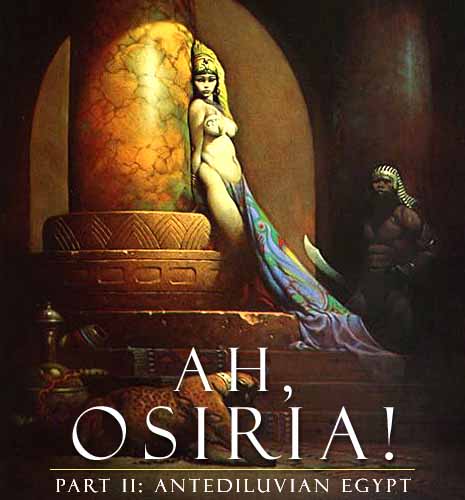
Editorial
|
Press Releases
|
Book Reviews
|
Fragments
Serpent Mound II
|
Giants II
|
Osiria II
Register
for our new Hall of Records Newsletter!
Questions? Comments? Suggestions? Advertising? Press Releases?
Contact us!
Part I: The Athenian Empire
|
Part III: Nimrod Hunting
|
Part IV: The Beast from the Sea
Ah, Osiria! Discussion Board
(Requires Registration)
The Land of Osiris
|
The Antediluvian Egyptians
|
The Giza Power Plant
The Giza Death Star
|
A Canticle for Osiris
Osiria Links
|
Osiria Books
|
Osiria Audio
|
Osiria DVD
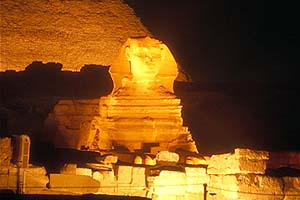
The Great Sphinx. At the heart of the legend of the Sphinx lies "the Riddle of the Sphinx", a legend that has been passed down to
us through the Greek play
Oedipus Tyrannus. In the play, the Sphinx is described as a menace, lying in wait to capture unsuspecting travelers in Egypt.
Once she caught them, if they were unable to answer
her riddle,
she devoured them.
|
 ur search for the ancient empire of Osiria, and the 14 lost pieces of Osiris believed by some to be scattered throughout that now largely submerged land, leads us now to the motherland of its namesake: Egypt. Actually known to its ancient inhabitants as "Khemet", since the most ancient times Egypt has been to some the mother of the world's most ancient mysteries, and to others, the mother of the world's most ancient iniquities. And the greatest symbol of the ancient mystery that is Egypt is the Great Sphinx, perhaps the most commonly known symbol of ancient Egypt on Earth. Still she lies recumbent, silently guarding the Giza necropolis, an ever-present reminder of Egypt's hidden past and the mysteries that still lie buried beneath its haunted sands. Ever desirous to divulge her secrets to a world not yet prepared, she lies chastely waiting for the one who holds the key to her heart of darkness.
ur search for the ancient empire of Osiria, and the 14 lost pieces of Osiris believed by some to be scattered throughout that now largely submerged land, leads us now to the motherland of its namesake: Egypt. Actually known to its ancient inhabitants as "Khemet", since the most ancient times Egypt has been to some the mother of the world's most ancient mysteries, and to others, the mother of the world's most ancient iniquities. And the greatest symbol of the ancient mystery that is Egypt is the Great Sphinx, perhaps the most commonly known symbol of ancient Egypt on Earth. Still she lies recumbent, silently guarding the Giza necropolis, an ever-present reminder of Egypt's hidden past and the mysteries that still lie buried beneath its haunted sands. Ever desirous to divulge her secrets to a world not yet prepared, she lies chastely waiting for the one who holds the key to her heart of darkness.

Osiris, both the man and the myth, was not born until after the Great Flood had destroyed the civilization that now bears his name.
As we have seen,
the worship of Osiris was at one time so widespread throughout the ancient Mediterranean world that some have taken to referring to the ancient, pre-Flood Mediterranean region as "Osiria". For want of the correct name, which has been lost to history, we have opted to retain the name Osiria for this ancient civilization that once stretched from southern Europe to North Africa, from ancient Canaan to the Pillars of Hercules. Childress explains this fantastic lost civilization of the Mediterranean in his classic
Lost Cities of Atlantis, Ancient Europe & the Mediterranean,
The Osirian Civilization, according to esoteric tradition, was an advanced civilization contemporary with
Atlantis.
In the world of about 15,000 years ago, there were a number of highly developed and sophisticated civilizations on our planet, each said to have a high degree of technology.... It is said that at the time of Atlantis and Rama, the Mediterranean was a large and fertile valley, rather than a sea as it is today.... This huge, fertile valley, along with the Sahara (then a vast fertile plain), was known in ancient times as the Osirian civilization. The Osirian civilization could also be called "Pre-Dynastic Egypt," the ancient Egypt that built the Sphinx and pre-Egyptian megaliths such as the Osirion at Abydos. In this outline of ancient history, it was the Osirian Empire that was invaded by Atlantis, and devastating wars raged throughout the world toward the end of the period of Atlantis' warlike imperial expansion.1
As we saw in
Part I,
Osiria was not a true empire, but a collection of allied peoples who had once lived in the regions in and around the Mediterranean basin for many thousands of years until they had been destroyed by the Great Flood. The Great Flood, besides destroying the Osirian peoples and burying the majority of their remains, had also filled in the basin, creating what is now known as the Mediterranean Sea. The archaeological heritage left behind by these antediluvian peoples takes the form of massive, megalithic structures, the term "megalithic" referring to the incredible size of the stones that they had used to construct their temples, palaces and pyramids. It is these unique structures by which the antediluvian Osirians can be distinguished from their descendants in the region, who built on a much smaller scale with brick and stone of a size miniscule by comparison with the massive monoliths that had been used to construct the world before the Flood.
The Osirian peoples, among whom the antediluvian ancestors of the Athenian Greeks had been foremost, had been attacked shortly before the Flood by the
Atlanteans,
who had had designs on creating a global Atlantean Empire. Of all of the Osirian peoples, all but the Athenians had fled in terror of the Atlantean onslaught, who then stood alone against the armored fist of the massed Atlantean naval and groud forces. However, instead of fleeing in terror as had the rest of their Osirian allies, antediluvian Athens had "shone forth, in the excellence of her virtue and strength" and had defeated the Atlanteans, driving them from the Mediterranean region and freeing "all who dwelt within the pillars" from the Atlantean yoke. But then, in a single day and night, both Athens and Atlantis disappeared beneath the waves in an event that is generally believed to be the same as that described in the Bible as the Great Flood of Noah.

One of the Osirian peoples who had been allied with the antediluvian Athenians were the antediluvian Egyptians. Like ancient Athens, Egypt also had a history that preceded the Great Flood and, also like ancient Athens, it had its share of megalithic structures left over from the world before the Flood. In fact, not only does Egypt have a significant amount of anomalous megalithic structures scattered around the Nile Valley, some of these structures remain today as some of the most famous archaeological relics on Earth. All have been classified by mainstream science as the work of pharaohs during the dynastic period, despite the fact that the art and architecture of these megalithic structures is completely different from that of classical Egyptian architecture.

The first and most famous of the antediluvian artifacts of Egypt that we will examine is
the Great Sphinx
of Giza. Known throughout the world for its enigmatic gaze and famous in ancient literature for its mysterious
riddle,
the Sphinx is thought by some to be many thousands of years older than is currently believed. This is due to the fact that both the Sphinx and the walls of the Sphinx enclosure show evidence of a significant amount of water erosion, a type of water erosion that could only have been caused by substantial rainfall over a period of thousands of years.

|
|
A closeup of the rain-eroded walls of the Sphinx enclosure. Geologist Robert Schoch,
among others, has determined that this sort of undulating profile could only be created
by long-term exposure to heavy rains.
Image from
The Message of the Sphinx.
|
This water erosion first was discovered on both the Sphinx and on the walls of the Sphinx enclosure by the French mathematician
R.A. Schwaller de Lubicz,
who had spent 15 years touring Egypt during the first half of the twentieth century. de Lubicz had concluded that the erosion on the Sphinx and the walls of the Sphinx enclosure must date back to a period when Egypt received copious amounts of rainfall, and the last time that Egypt had received that much rainfall had been between 10,000-8000 b.c., around the end of the last Ice Age. de Lubicz's work, though largely ignored, has since helped to usher in a new era of archaeological debate on the true history of the Sphinx.
de Lubicz's research was followed up on during the 1980s by the maverick Egyptologist
John Anthony West,
who had teamed up with a professional geologist named
Robert Schoch
of Boston University with the express purpose of putting de Lubicz's conclusions to the test. From their research West and Schoch made an Emmy award-winning video,
The Mystery of the Sphinx,
which made its debut on NBC in 1993. In that video, West and Schoch proved conclusively that de Lubicz's theories regarding the true age of the Sphinx were accurate. Schoch, a professional geologist, carefully studied the erosion patterns that are especially prominent on the hindquarters of the Sphinx and on the walls of the Sphinx enclosure, and stated definitively that it must have been the result of centuries of rainfall beating down on the limestone, as that is the only way that the sort of undulating, vertical grooves and channels found there could have been created. Furthermore, the depth of the erosion could only have been created as the result of water running down over the surface of the limestone over a period of hundreds or even thousands of years. Thus, it is entirely possible that the Sphinx may be not only much older than the usual date of 2500 b.c., but it may actually predate even the Great Flood — which most likely occurred around 10,000 b.c. — by thousands of years.
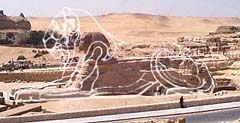
|
|
In
The Mystery of the Sphinx,
West and Schoch also point out that the current head of the Sphinx is far too small for its body, proving that it must have been carved from a much larger head that had become so eroded as to require recarving. This image overlay proves their thesis, that the Sphinx's head must have originally been much larger, and was likely recarved at least once since its creation by kings who had long since forgotten its original meaning.
Image adapted from
Guardian's Egypt.
|
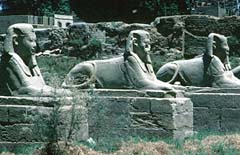
|
|
The heads of all other sphinxes found in Egypt were, in fact, carved proportionally, as seen at the Avenue of Sphinxes discovered in Luxor.
Image from
The Oriental Institute.
|
Next in importance to the geologic evidence for the great antiquity of the Sphinx is what could be referred to as the "aesthetic" evidence. We have seen that the Sphinx exhibits an extreme level of wind and water erosion on its body, the head appearing to have been affected the most. However, few seem to notice that the head is proportionally far too small for the body — so small, in fact, that it is less than half the size it should be compared to that of a lion, the model upon which all other sphinx sculptures were based. This is unlikely to have been purposeful, as all the other sphinx sculptures that that have been found in Egypt — all of them — have heads that are proportional to their bodies. Therefore, the most logical conclusion is that the head was originally much larger but, due to extreme erosion, it has been recarved at least once.
In fact, it is entirely possible that
Pharaoh Khafre,
the Pharoah who is typically credited for the building of both the Sphinx, the Sphinx Temple and the
Great Pyramid of Khafre,
rather than having created the Sphinx, had merely recarved the pre-existant Sphinx in his own graven image. The fact that the Sphinx actually
looks nothing like Khafre
probably means that another Pharoah may have recarved it yet again, explaining why the head has become so small. The practice of erasing the names of previous rulers and taking credit for their work was an established tradition in ancient Egypt, and having one's face on the Sphinx was likely the most coveted prize of all. Thus, not only the geologic evidence, but also the aesthetic and cultural evidence leans strongly towards the conclusion that the current head of the Sphinx has probably been recarved at least once since its original creation.
Technically, the Sphinx is not a megalithic structure, as it had originally been carved as a single sculpture from a massive rock outcropping as opposed to having been built out of large, fitted stones as is typical of megalithic architecture. However, we know for a fact that the stone that was cut out from around the Sphinx while it was being carved was later used to build what is commonly known as the "Sphinx Temple", a massive, megalithic temple complex that sits right in front of the paws of the Sphinx.
As we have seen
in our study of the megalithic structures of Malta, the megalithic style of architecture used in the Maltese temples was apparently typical of that used in the world before the Flood. This conclusion was based largely on the fact that those temples show strong evidence of having been literally knocked over by one or more massive tsunami, huge tidal waves that had deluged the entire Mediterranean basin at some point in the distant past in an event that we have determined was most likely part of the Great Flood of Noah. So, the megalithic style of architecture to be found in Malta, Egypt and elsewhere may well be indicative that the structures that were built using the megalithic style are in fact archaeological remnants of the world before the Flood.
In conclusion, between the water erosion to be found on and around the Sphinx, the apparent recarving of the head of the Sphinx due to extreme levels of erosion over many thousands of years, and the fact that the materials cut out from around the Sphinx were used as building materials for a temple whose architectural style greatly predates that of Egypt's dynastic period, the evidence appears to strongly suggest that the Sphinx may indeed be much older than currently believed — possibly old enough to be an archaeological remnant of the world before the Flood.

The Sphinx Temple
stands immediately before the Sphinx, and is made up of the same materials as the Sphinx, the limestone blocks used to build the temple having been quarried from around the Sphinx in the process of creating the Sphinx enclosure. Unfortunately the Sphinx Temple is almost completely ruined. Once a magnificent megalithic temple built of massive limestone blocks with granite facing stones and an alabaster floor, it now lays in ruins, a jumble of blocks splayed out in front of the paws of the Sphinx like so many children's toys. In fact, the chaotic jumble of the temple's massive stones looks chillingly reminiscent of the destruction that had been wrought by
the Great Flood
on the Maltese temples. Could the tsunami that destroyed the capitol of Osiria have reached as far as Egypt?
If indeed the Egyptians of the dynastic period were the descendants of
Canaan,
the son of Ham, the son of Noah, it may be that the Canaanites that had migrated to Egypt after the Flood had found the ruins of antediluvian Egypt that had been destroyed by the Flood and, not fully understanding the true purpose of the ruined megalithic structures, created lesser, imperfect copies of them in a vain attempt to recreate the glory of the days before the Flood. As a result, the ruins of the Sphinx Temple were likely still held sacred and used for religious ceremonies, though their original purpose was likely never fully understood. Over time, additional temples and worship structures were built, all based on false assumptions about the true nature of the mysterious megalithic structures that dotted the Giza plain. However their attempts were all in vain, as the structures that they built were never quite as good as those that had been built before the Flood. Eventually, lost in darkness, Egypt went into decline and was conquered by one empire after another, her priesthoods scattered to the four winds, taking the true history of Egypt with them.
Like the Sphinx, the Sphinx Temple has been incorrectly attributed to
Khafre,
one of the more famous of the Old Kingdom pharaohs. However, as we have seen, the megalithic style of architecture greatly predates the Egyptian
Dynastic Period.
The Sphinx Temple has no carvings or paintings whatsoever, whereas the temples of Egypt's historical period were literally covered inside and out with deeply engraved, brightly colored artwork. The Sphinx Temple, like all megalithic structures, was unique in its simple construction and complete lack of ornamentation, indicative of a completely different style of construction where function clearly ruled over form.
More likely Khafre, like
Thutmoses III
would later do, merely renovated the Sphinx and the surrounding megalithic temples that were already very ancient even by his time. Thus the fact that there are archaeological remains from Egypt's historic period in the Sphinx Temple and its surroundings does not prove that they were built in those periods. It is most likely that these were later additions by the Egyptians who, like all peoples, tended to build on and reuse more ancient structures, not understanding their original usage. Unfortunately, closer inspection in an attempt to divine the original usage of the temple is now impossible, due to the fact that it has been placed off limits indefinitely for reasons not yet disclosed.

Just to the left of the mysterious Sphinx Temple, as one is looking towards the front of the Sphinx, is the equally mysterious
Valley Temple.
Like the Sphinx Temple, the Valley Temple was also built of the same huge, megalithic stones that had been quarried from the area around the Sphinx. The huge size, shape, and style of architecture matches the Sphinx Temple perfectly, meaning that the Valley Temple had been built at the same time as the Sphinx and the Sphinx Temple and, as we have seen, possibly even the megalithic structures at Malta. Like the Sphinx Temple, even a casual observer can see that there is a world of difference between these ancient megalithic temples and the relatively modern structures that vainly attempted to emulate them.
The Valley Temple at Giza, traditionally attributed to the Pharaoh Khafre, is an absolute wonder of engineering, and its distinctive architectural style identifies it as being among the oldest stone buildings in Egypt, if not the world. The only other known parallels in Egypt are the Sphinx Temple right next to it, and the mysterious Osirion at Abydos, in Upper Egypt.
What makes the Valley Temple so remarkable is the sheer size of the stones used in its construction, and the incredible number of them used. The temple itself is roughly square, measuring 147 feet on each side, and it is built into the slope of the plateau with the height of its exterior walls rising from just over 20 feet on the west side, to over 40 feet on the east side. Its core structure is built entirely of huge limestone blocks, hundreds of them, regularly exceeding 200 tons each in weight, the equivalent of nearly 300 family-sized cars!
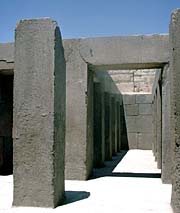
|
|
The huge
trilithons
of the Valley Temple are simply two massive blocks surmounted by a third massive block — literally, the simplest possible method of construction. At hundreds of tons each, however, the question remains as to how they were lifted into place, as it would be difficult or impossible to perform the same feat today.
Image from
The Oriental Institute.
|
Not content with using hundreds of 200-ton blocks of limestone, the builders of the Valley Temple had also managed to lift these huge stones to heights of over 40 feet! To give some kind of perspective, the largest sarsen stones at the famous Stonehenge in Southern England weigh a mere 50 tons, and they were not lifted to anywhere near these heights. The engineering logistics are simply incredible.2
Once again, like the Sphinx and the Sphinx Temple, the Valley Temple stands as mute testament to a world far older than the one currently recognized by orthodox Egyptology. At 200+ tons, these stones could not have possibly been raised up to 40 feet in the air by any technology known to be available to the dynastic Egyptians, and even today we would be sorely pressed to lift just one of them. The clean, simple, unadorned style of the Valley Temple's megalithic architecture is also distinctly different from that of Egypt's historic period, which was always sophisticated and ornate. Yet, orthodox Egyptology continues to attribute this temple to Khafre based solely on the fact that a statue of Khafre had been found in the temple buried upside down in a pit. Yet, pharaohs placing statues of themselves in temples that were built well before their time was a common practice in Egypt, usually accompanied by a renovation or expansion of the temple complex. So, the discovery of Khafre's statue could well indicate that he merely renovated the existing temple, rather than building it.

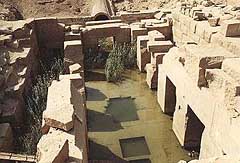
|
|
The Osirion is probably the most mysterious of all of the megalithic temples of ancient Egypt, as it is not only made up of massive square blocks comparable in size, shape and weight to those used in Malta and Giza, but it was also found buried some 50 feet into the ground lower than the Seti temple that was supposedly built at the same time, by the same person.
Image from
Tour Egypt.
|
The Osirion,
located in Abydos, is perhaps the most famous of Egypt's megalithic temples. Attached to Seti I's "Temple of Osiris",
the Osirion
is generally referred to as the "Tomb of Osiris", though its exact function has never been determined definitively. Mainstream Egyptologists claim that it was built by
Seti I,
some even going as far as to claim that it was made purposely "old looking" in order to make it appear to be from the Old Kingdom period as supposedly the Sphinx Temple and Valley Temple were. Despite the fact that this idea is patently absurd, there were some inscriptions from Seti found on the site which do lend some credence to their claim that the temple complex — if that is indeed what it was — was built by Seti. However, for many reasons, it is much more likely that the Osirion is yet another antediluvian megalithic temple that had been repurposed for use by the post-Flood inhabitants of Egypt. As Fletcher explains,
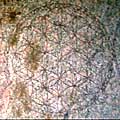
|
|
The only original inscription to be found in the Osirion was this mandala-like motif popularly known as "the Flower of Life".
Above: Original inscription
Below: Popular reconstruction
Images from
Flower of Life Research
|

|
In the mid-1920s, archaeologists digging in the scorching climate of Abydos discovered the walls of a temple that for thousands of years had been completely buried by silt and sand. Well, at least they thought it was a temple. When the structure was completely uncovered, swept out, and polished, these Egyptologists realized that what they had stumbled upon might not have been a temple after all, but something completely unique to their craft. Analogous granite walls and columns had not been previously discovered anywhere else in Egypt. It appeared certain that this discovery could turn Egyptology upside down and severely challenge the accepted academic position regarding Egypt�s past.
One of the first theories introduced about the Osireion was that it was the tomb of the famous antediluvian King Osiris, whose existence had been previously dismissed as mere fantasy. This seemed to make logical sense since the Osireion had been discovered in Abydos, which for thousands of years had been worshipped as the location of the tomb of Osiris, even though no definitive tomb of the legendary pharaoh had ever been found there. Thus, the first plausible explanation was that the archaeologists had stumbled upon the tomb of the legendary Osiris, the greatest pharaoh in history.3
Whereas the architectural style of Seti's temple is distinctly New Kingdom, the Osirion's megalithic architecture is completely different. Also, whereas the walls of Seti's temple are covered inside and out with hieroglyphs and painted scenes depicting the king's life, the walls of the Osirion are completely bare save those few intrusive etchings that Seti had imposed upon them, and a single enigmatic symbol, known as the
"Flower of Life", that was probably the only original inscription.
In fact the Osirion is nothing like the temple of Seti, a New Kingdom temple structure which is clearly yet another late addition by the post-Flood Egyptians to the antediluvian structures they came across when they repopulated the land. Repurposing these ancient structures to fit their strange, superstitious religion, the ancient descendants of Ham had little or no idea of what the structures were really used for. And until recently, neither did we.

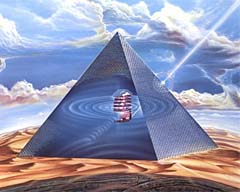
|
|
Christopher Dunn
in his seminal
The Giza Power Plant
argues very convincingly that the Great Pyramid of Giza was originally used not as a tomb, but as a method of generating energy, in
effect, making the Giza necropolis the shattered remnants of an ancient "power plant".
Image from
The Giza Power Plant
|
As we have seen,
the antediluvian world
was a world that was extraordinarily wicked. It was a world at war with itself, a world that was utterly bent on its own destruction. Many ancient traditions including even the Bible describe the antediluvian world as a place that was populated largely by technologically sophisticated
giants
who lived only to make war, a world so irretrievably wicked that it had to be totally destroyed by the Great Flood.
We are told that all of the wicked world from before the Flood was destroyed. Unfortunately, that appears to not be the case — much of the antediluvian world appears to have escaped the cleansing destruction that was inflicted upon it. The megalithic architecture to be found around the world is almost certainly from the world before the Flood, from a time when the technology to lift massive objects with relative ease was apparently widely available. Some also believe that radio, television, electricity and similarly high technologies were also available, and were linked to some of these megalithic structures. And of all these structures, the Great Pyramid appears to have been the greatest — and most dangerous — megalithic remnant of the antediluvian world.
Some believe that the Great Pyramid lay at the heart of the civilization of the antediluvian Egyptians not as an object of worship and veneration, but as the central piece of a gigantic power plant — the
"Giza Power Plant"
— that generated electricity and other forms of power that were used not only for communications and power generation for peaceful use, but also as a weapon of terrible destruction. As such, the antediluvian Egyptians were in possession of a technology that, until the twentieth century, far exceeded our own.


|
|
One of the classic reliefs from the Temple of Hathor that clearly show various forms of what is now known as the
Crookes tube,
a form of light bulb, being used to shed illumination.
Some believe that this is how the ancient Egyptians were able to paint the tombs deep underground without the use of torches, which
would have left telltale residue. The number and variety of the lightbulb images is more suggestive of a research facility, making
the Temple of Hathor possibly more of what we would consider to be a laboratory than a house of worship.
Image from
Conscious Evolution
|
Increasing evidence is coming to light suggesting that the ancient Egyptians did indeed have advanced technology. As David Hatcher Childress explains in his fascinating
Technology of the Gods: The Incredible Sciences of the Ancients,
In my searches for lost cities and mysteries of the past, I have often found clues to the technology of the ancients. These clues can be in the form of depictions of ancient devices in rock paintings or carvings (such as the electric devices at the Temple of Hathor in Egypt) or as small models of devices (such as the miniature gold airplanes at the Bogota Gold Museum) or in the stories from ancient texts (such as the Ramayana or even the Bible).... In the ancient world high technology was largely denied the masses. In fact, it was often used in temples and ceremonies to gain power over people by amazing or terrifying them; this was part of worship and mystery.4
Unfortunately unlike today, where most technology is freely available to the public, the Egyptian priesthoods kept the technological knowledge to themselves in order to keep the peasants docile and easily controlled. And in order to maintain their power over the peasantry, the priests no doubt occasionally arranged spectacular lightshows to make sure that the peasantry knew of their superior power, that "the gods" were on their side. Now of course, we have and understand electricity and the many conveniences that it provides. However, to the Egyptians, these "technologies of the gods" were part of the mysteries of the gods. These mysteries included what we now know as electricity, radio, television and, possibly, even nuclear power. Moreover, as we shall see, some believe that the antediluvian Egyptians may have also been in possession of a technology that may have made even nuclear weapons obsolete. However, let us look at some of the better known "mysteries of the gods" first:
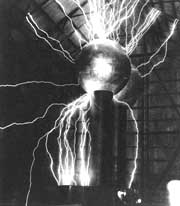
|
|
The very first (modern) Van de Graaf generator, created by Dr. Robert J. Van de Graaff, an MIT professor. It was used originally
as a research tool in atom-smashing and high energy X-ray research. Used by the Egyptian priesthoods in their rituals, its
psychological effect must have been awesome indeed.
Image from
Museum of Science
|
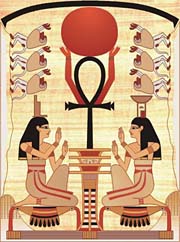
|
|
Image of an Egyptian Van de Graaff generator.
Isis
and
Nephthys at the bottom sit on the sign for
gold,
nebu, which is a superior power conductor. The
djed column
means stability, acting as a stable base for the generator, the term possibly also meaning "insulator" in this context. The
ankh
means the power of life, or electrical power. The round symbol is the solar disk, or a source of light, as the case
may be. The current understanding of the ankh and solar disk as merely symbolic of life is the result of a degeneration of ancient
Egyptian thought, where superstition had taken the place of science.
Image courtesy
KennyZen
|
 E L E C T R I C I T Y
E L E C T R I C I T Y
The most illuminating evidence of Egyptian knowledge of electricity comes from the
Temple of Hathor
in Denderah, Egypt in the form of a mysterious relief that appears to depict what could only be a massive lightbulb (above). Electrical engineers have studied the design and determined that the carvings on the temple walls actually represent a type of lightbulb called a
Crookes tube.
Chris Dunn explains in his seminal work,
The Giza Power Plant,
When the [Crookes] tube is in operation, the ray originates where the cathode electrical wire enters the tube to the opposite end. In the temple picture, the electron beam is represented as an outstretched serpent. The tail of the serpent begins where a cable from the energy box enters the tube, and the serpent's head touches the opposite end. In Egyptian art, the serpent was the symbol of divine energy.... The Temple picture shows one tube, on the extreme left of the picture, to be operating under normal conditions. But with the second tube, situated closest to the energy box to the right, an interesting
experiment
has been portrayed. Michael R. Freeman, an electric and electromagnetic engineer, believes that the solar disc on Horus' head is a
Van de Graaf generator,
an apparatus which collects static electricity. A baboon is portrayed holding a metal knife between the
Van de Graaf-solar disc
and the second tube. Under actual conditions, the static charge built up on the knife from the generator would cause the electron beam inside the Crookes tube to be diverted from the normal path, because the negative knife and negative beam would repel each other. In the temple picture, the serpent's head in the second tube is turned away from the end of the tube, repulsed by the knife in the baboon's hand.5
According to Dunn, all aspects of the Denderah reliefs correspond exactly to modern electrical specifications. The bulb size and shape, the position of the elements relative to each other, and even the wiring patterns and insulators all match their modern counterparts. The arrangement and variations in the examples of how to manipulate the electrical energy of the bulb is also strongly reminiscent of modern scientific diagrams, the only major difference being the use of symbolic imagery, such as gods and animals, to communicate certain concepts.
 R A D I O
R A D I O
Another technology that some believe the antediluvian Egyptians possessed was radio.
Stephen Mehler
believes that the Great Pyramid may have been, among other things, a gigantic communications tower that no doubt was used to unite mankind.
As Mehler explains,
One of the uses of the Great Pyramid was to serve as a giant radio station to send messages all over the earth.
Kinnaman
claimed that there was a passageway off of the secret entrance they found in the south-east corner of the Great Pyramid that led to a spiral staircase that took them down over 1,000 feet into the limestone bedrock. There, in a large room lying on a stone table, was a giant quartz crystal ground convex that was 30 feet in every direction (long, high, thick, etc.). This giant crystal with thousands of prisms inserted in it was the source of the radio transmission.6
Interestingly,
early radio sets
used
crystal radio
technology, before
vacuum tubes,
solid-state
transistors
and other methods were developed during a long
history
of development.
If the antediluvian Egyptians had discovered radio, it stands to reason that television was not far behind.
 T E L E V I S I O N
T E L E V I S I O N
Of all of the visionaries and seers who claim to have seen visions of the world before the Flood,
Edgar Cayce,
famous seer and mystic, stands head and shoulders above all. Cayce claimed to see through the eyes of his subjects into their past lives, many of whom apparently had had past lives in Atlantis. And in many of these visions, Cayce described television as one of the technologies that was a part of the antediluvian world:
In city of Peos in Atlantis � among people who gained understanding of application of nightside of life or negative influences in the Earth's spheres, of those who gave much understanding to the manner of sound, voice and picture and such to peoples of that period.... In Poseidia the entity dwelt among those that had charge of the storage of the motivative forces from the great crystals that so condensed the lights, the forms of the activities, as to guide the ships in the sea and in the air and in conveniences of the body as television and recording voice.7
So not only did the antediluvian Egyptians (and
Atlanteans)
have radio, they also had television. Moreover, according to Cayce, they were able to transmit both radio, television and even power to various craft through the airwaves. Apparently it had to do with the same crystal technology that was used for radio transmission. So, in effect, the Great Pyramid was not only a huge power plant, but it was also a gigantic radio/TV broadcast tower.
 N U C L E A R P O W E R
N U C L E A R P O W E R

|
|
Libyan Desert glass, or "LDG", can be found covering hundreds of square miles of the Libyan Desert in southwestern Egypt. LDG was used
to fashion a glass scarab that was found on the breast of Tutankhamen (below). The glass
is extremely pure, and could only be formed by a blast of extreme heat, which could only generated by either a meteorite
that exploded just above the desert, or a nuclear weapon, though the evidence appears to clearly point to the latter. Childress
also suggests that the glass might also be the result of an even more powerful energy weapon, currently unknown, but possessed by
the antediluvian Egyptians.
Images from
Egyptologists' Electronic Forum
|
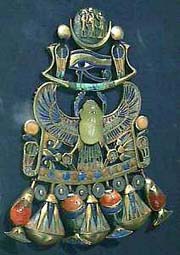
|
Though evidence of nuclear power — specifically, nuclear weapons — is not directly evidenced in Egyptian myths and artifacts, evidence of ancient nuclear war does exist in southwestern Egypt, in the form of a vast
desert
of fused glass. Childress explains,
One of the strangest mysteries of ancient Egypt is that of the great glass sheets that were only discovered in 1932. In December of that year, P. Clayton, a surveyor for the Egyptian Geological Survey, was driving among the dunes of the Great Sand Sea near the Saad Plateau in the virtually uninhabited area just north of the southwestern corner of Egypt, when he heard his tires crunch on something that wasn't sand. It turned out to be large pieces of marvelously clear yellow-green glass. In fact, this wasn't just any ordinary glass, but ultra-pure glass that was an astonishing 98% silica. Clayton wasn't the first person to come across this field of glass, as various "prehistoric" hunters and nomads had obviously also found the now-famous Libyan Desert Glass or
LDG.
The glass had been used in the past to make knives and other sharp-edged tools as well as other objects. A carved scarab of LDG was even found in Tut-Ankh-Amen's tomb, indicating that the glass was sometimes used for jewelry. An article in the British science magazine New Scientist (July 10, 1999) by Giles Wright entitled, "The Riddle of the Sands," says that LDG is the purest natural silica glass ever found. Over a thousand tons of it are strewn across hundreds of kilometers of bleak desert. Some of the chunks weigh 26 kilograms, but most LDG exists in smaller, angular pieces looking like shards left when a giant green bottle was smashed by colossal forces.8
There can only be two possibilities for the green glass desert in southwestern Egypt: one, a meteorite exploded over the desert in a
Tunguska-like
event or, two, there was a nuclear explosion in the desert, either as the result of an attack, or because the desert was used as a testing range like our
Alamagordo Desert
in New Mexico, the result of which was also sand being fused into green glass. Ancient nuclear war has been considered as the answer to some of the more puzzling anomalies to be found around the globe, including references in the
Mahabharata
to a mighty weapon that sounds exactly like a nuclear missile:
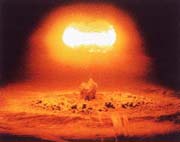
|
|
If the radiance of a thousand suns
Were to burst at once into the sky
That would be like the splendor of the Mighty one...
I am become Death,
The destroyer of worlds.
— from the Bhagavad-Gita
|
Gurkha, flying a swift and powerful vimana hurled a single projectile charged with the power of the Universe. An incandescent column of smoke and flame, as bright as ten thousand suns, rose with all its splendor. It was an unknown weapon, an iron thunderbolt, a gigantic
messenger of death, which reduced to ashes the entire race
of the Vrishnis and the Andhakas.
The corpses were so burned as to be unrecognizable.
Hair and nails fell out; Pottery broke without apparent cause,
and the birds turned white.
...After a few hours all foodstuffs were infected...
...to escape from this fire the soldiers threw
themselves in streams to wash themselves and their
equipment.9
Interestingly, there are persistent reports of an ancient city in India that is covered in a layer of radioactive ash that shows evidence of an atomic blast that occurred somewhere between 10,000-6000 b.c., which fits into the timeline that we have determined for the last world war of the antediluvian world, and of the Flood that wiped them out for good.10
A third possibility has been suggested by Childress that the fused green glass was as a result of a previously unknown energy weapon of which the antediluvian Egyptians had the mastery.

There has always been something about
the Great Pyramid of Giza
that has excited the imagination of men more than any other pyramid in the world. Though this so-called
"Pyramid
of
Khufu"
is nearly identical in size to its twin, the so-called
"Pyramid of Khafre",
it has excited the imagination so much more because deep within its dark interior lies a mysterious series of
rooms and passageways
whose true purpose has long remained a mystery. Moreover, these passageways exhibit such a
high level of precision
in their manufacture that even today we would be sorely pressed to reproduce them. Though mainstream Egyptologists are adamant that the
Great Pyramid
was meant to serve as a tomb for Pharaoh Khufu, like all the other antediluvian megalithic ruins we have discussed, the
Great Pyramid
has absolutely no inscriptions inside or outside, funereal or otherwise. This is wholly different from every other Egyptian tomb ever found, which invariably have practically every square inch of wall, and even ceiling, covered in beautiful inscriptions and paintings. Moreover, not a single artifact, relic, sarcophagus or treasure of any kind has ever been found inside the Great Pyramid, even by the Egyptian Caliph
Al-Mamoun,
who was the first to enter the interior workings of the Great Pyramid since it was sealed ages ago.

|
|
Howard Vyse's disputed cartouche of Pharaoh Khufu found in the upper relieving chambers of the King's Chamber. Questions remain as to
its authenticity, and to why the only reference to a dynastic pharaoh is to be found in an inaccessible area of a pyramid in which no
other inscriptions have ever been found.
Image from Guardian's Egypt
|
Yet, despite the complete lack of evidence for the Great Pyramid being a tomb, temple or memorial of any kind, Egyptologists continue to insist that the Great Pyramid was indeed the tomb of Pharaoh Khufu. This is based on a single, highly dubious bit of graffiti that had been found in the formerly sealed
"relieving chambers"
above the so-called "King's Chamber" in 1837. This graffiti was found by one
Howard Vyse,
the 19th century Egyptologist, who claimed that the hieroglyphics, that were crudely daubed in red paint, spelled out the name of Khufu and were therefore proof that Khufu had built the Great Pyramid. Beyond the obvious question as to why this tiny, insignificant mark in an area sealed off from human contact was the only identifying mark in the entire pyramid, is the questions about the provenance of the graffiti. Following up on the problem, noted authors
Graham Hancock
and
Robert Bauval
nicely did away with Vyse's scurrilous attempt to rewrite history by pointing out that not only were the hieroglyphs of
dubious lineage,
they were also misspelled! Furthermore, the manner in which Khufu's name was misspelled matched exactly a typo that appeared in the book on Egyptian hieroglyphics that Vyse had used for translation work.11 This dubious mark is hardly enough to determine absolutely the builder of perhaps the greatest artifact of the antediluvian world left on Earth. Nor will it dissuade us from discovering the Great Pyramid's true purpose.
Now that it is safe to dismiss academic Egyptology's assessment of the age of the Great Pyramid, the door is open to other theories. And there have been numerous theories, to the pyramid as part of a
treasure map
to the pyramid as a
water pump.
And though the treasure map theory is excellent, perhaps the best Great Pyramid-specific theory so far is
Christopher Dunn's
"power plant"
theory. This theory, combined with the complementary research of Joseph Farrell and my own deductions, is as follows: the Great Pyramid of Giza utilized a combination of hydrogen, tectonic "earth" energy, solar energy, lunar energy and quartz crystal in various forms to synergize an immense amount of energy that was essentially the central "power plant" of antediluvian Egypt.
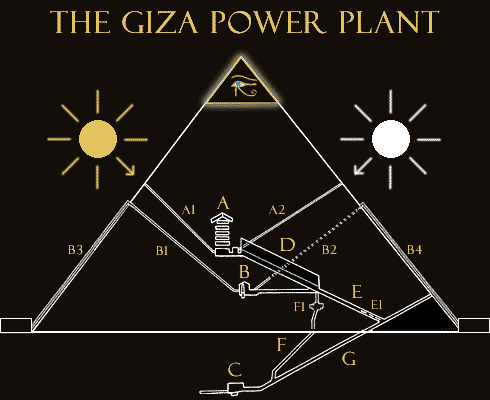
|
|
A: The "King's Chamber": Hydrogen, sound energy, and solar/lunar energy was collected here and amplified by crystals.
A1 & A2: Solar energy & lunar energy (reflected solar, microwave and other types of energy from
space) collected through these shafts. The northern and southern faces were originally shaped like satellite dishes, with collectors
to collect and transmit the energy into the King's Chamber via the shafts.
B: The "Queen's Chamber": Hydrogen produced here by mixing zinc chloride and hydrochloric acid
B1: Hydrated zinc chloride is piped in from the outside through the shaft into the Queen's Chamber
B2: Hydrochloric acid is piped in from the outside through the shaft into the Queen's Chamber
B3 & B4: It is possible that the zinc chloride and hydrochloric acid was piped in from the outside,
but no external opening has been found. A subterranean chamber in or beneath the pyramid may eventually be found that supplied these
or other chemicals for the reaction.
C: The "Subterranean Chamber": A lesser resonating chamber that produces the bass and sub-bass notes
D: The "Grand Gallery": The primary resonating chamber, produces the midrange and high notes that, along
with the bass from the Subterranean Chamber, creates an
F-Sharp chord
that is channeled into the King's Chamber
E: The "Ascending Passage": Contains granite "plugs" (E1) that serve as sonic dampers to prevent runaway vibration
F: The "Well Shaft": Bass notes from Subterranean Chamber travel through here to Grand Gallery
G: The "Descending Passage": Access tunnel to the mechanism
For further explanation, read on.
|
 E A R T H E N E R G Y
E A R T H E N E R G Y
The first and most important part of the process is the tapping of earth's limitless supply of seismic energy, which creates the majority of the power plant's power. The Great Pyramid, as many researchers have discovered, was built with a degree of architectural precision that is unmatched even today. The perfectly squared base, oriented perfectly towards the four cardinal directions, is the aspect of the building that is perhaps the most commented-upon feature of the pyramid. What is less well known is the fact that the pyramid is not perfectly flat on the bottom, as one might expect. Instead, it is built upon an outcropping of limestone, the first few courses of stone built around the mound and later covering over it. This is important, as we shall see.
Dunn believes that the Great Pyramid was designed to be what is called a
"coupled oscillator"
with the Earth. A coupled oscillator is a device that is designed to allow the vibratory energy of one vibrating object to be picked up by a connected object so as to transfer the vibratory energy from the first object to the second object — in this case, from the Earth to the Great Pyramid. This is why the pyramid was not built upon a flat surface, but incorporates part of the Earth into its superstructure — the earth is effectively "coupled" with the Great Pyramid, allowing Earth's natural tectonic vibrations to easily pass into the pyramid. As Dunn explains, "Covering a large land area, the Great Pyramid is, in fact, in harmonic resonance with the vibration of the Earth — a structure that could act as an acoustical horn for collecting, channeling, and/or focusing terrestrial vibration."12
And there are other aspects of the pyramid's construction that help make it an extremely efficient coupled oscillator. For one, the Great Pyramid integrates into its design the concept of
pi,
where the height of the pyramid is the same as the ratio between the radius of a circle and its circumference. Just as 2 x pi x the radius of a circle = its circumference, so too 2 x pi x the height of the pyramid = its circumference. As such, like the Earth, (and all spheres) the Great Pyramid integrates into its structure the concept of pi, which helps it resonate with Earth's energy. Other aspects include the relative placement of the pyramid in the approximate center of Earth's land masses, its placement at precisely at 30 degrees north latitude, and many other interesting facts and figures that lend great weight to Dunn's theory too numerous to get into here.
The process of powering up the Giza Power Plant begins in the
Subterranean Chamber
(C), which was dug deep in the limestone bedrock beneath the pyramid. When the
Subterranean Chamber
was first discovered, the Egyptologists, caught in their "burial chamber" mindset, assumed that the rough-hewn, seemingly "unfinished" chamber had been abandoned by the Egyptians who decided instead to bury Pharaoh Khufu in a chamber higher up in the superstructure of the pyramid. However, if we look at the Subterranean Chamber as part of a larger resonating chamber intended to convert seismic energy into acoustic energy, its meaning and usage becomes clear.
The Subterranean chamber is a fairly small chamber that has two interesting features: "the Pit", and "The Dead-End Passage". The Pit is a twelve-foot deep pit (dug into deeper in 1837 by Howard Vyse, who was searching for a hidden chamber beneath it) that is just inside the entryway to the Subterranean Chamber, and the Dead-End Passage, a 2.5-foot square, 53-foot-long horizontal passage hewn into the living rock in the south side of the Subterranean Chamber. Outside of the "resonating chamber" paradigm the existence of these chambers makes no sense. However, if one looks at these chambers from the scientific perspective, with the idea that they had been created for a specific purpose, it becomes clear that these chambers had been created as a means of converting seismic energy to sound.
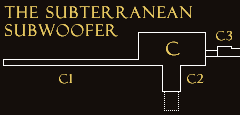
|
|
|
The Subterranean Chamber (C)
was originally built as a method of converting transverse and longitudinal seismic waves into sound energy of a very low frequency
— in effect, it was a subterranean "subwoofer".
"The Pit" (C2) was actually one part of this subwoofer that converted transverse waves into sub-bass sounds
(the dotted area
indicates Vyse's ill-fated attempt to find hidden treasure), and the Dead-End Passage (C1) was originally
designed to convert longitudinal waves into subbass, or possibly slightly higher frequency bass sounds than the pit. The size and
configuration of the pit and the passage would actually determine the type of sound that would be created, meaning that each
had been effectively "tuned" to generate a certain sound whenever they were hit with seismic energy, effectively making the
Subterranean Chamber a massive subwoofer. The small alcove (C3) outside of the main chamber may have been
intended to help regulate the amplitude of the sound, acting as a "limiter" to keep it from getting too loud before it was piped up
the descending passage and and "Well-Shaft"
(F) to the Grand Gallery.
|
|
Seismic energy takes the form of
two basic waveforms
while underground:
transverse waves,
and
longitudinal waves.
Transverse waves, also known as primary or compressional "P" waves, cause particles to oscillate parallel to the direction that the wave is traveling. Longitudinal waves, however, cause particles to oscillate perpendicular to the direction that the wave is traveling. So, in order to capture the energy from both types of waves, you would need to create two resonance chambers that are specially configured to capture and convert these two different types of energies — one vertically oriented, and one horizontally oriented — which is exactly how the sub-chambers that are found in the Subterranean Chamber complex are configured.
The Pit (C2) would be used to convert transverse waves, which would transfer their horizontal energy into its vertical sides, causing it to resonate like a subwoofer in a stereo system. The Dead-End passage (C1), conversely, would pick up and convert longitudinal waves, which would transfer their vertical energy into its horizontal walls, floor and ceiling, also causing it to resonate like a subwoofer. The reason for the rough condition of the Subterreanean chamber and its sub-chambers may be that the antediluvian Egyptians had actually manually "tuned" the chamber by digging out various parts of the floors. The very rough Pit may be the bass speaker or even the subwoofer, as very low frequencies are non-directional and do not require fine-tuning. The carefully carved Dead-End Passage, with its exact height and width of 2.5 feet, may have been effectively "tuned" to act more of a higher-frequency, "bass" speaker, slightly higher in frequency than the Pit subwoofer. If true, this implies that the entire pyramid is essentially a gigantic speaker system, where the Subterranean Chamber complex acts as the subwoofer as well as the bass speaker. Dunn believes that the frequency of the pyramid is actually 6 hertz, however, which would mean that the Subterranean subwoofer might actually be a subsonic subwoofer, producing sound that is below the threshold of human hearing. However, Dunn believes that it may still be detectable by the human body as physical vibration, which accounts for the strange feeling of "pyramid power" that people feel when entering the Great Pyramid.13
Thus the Subterranean Chamber would more accurately called the "Subterranean Subwoofer". But why did the antediluvian Egyptians have a need for such a huge subwoofer? And if it was indeed intended to be a gigantic speaker system, how were the midrange and high notes produced? By examining the acoustics of the inner chambers of the Great Pyramid, we can follow where the sound would go, and hypothesize on how it would behave. The heavy bass sound, which is non-directional, would flood through absolutely every opening, and even through the superstructure of the pyramid, like water. It would first travel up the "Well Shaft" (F), and then into the descending passage, up towards the entrance, causing every part of the pyramid to vibrate.
|
|
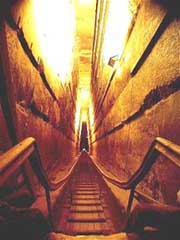
|
|
|
The so-called "Grand Gallery" of the Great Pyramid, as viewed from the top. The Grand Gallery was actually a massive acoustical
resonating chamber that was filled with 27 vertical rows of Helmholtz resonators, that converted seismic energy into sound. Note the
corbelled walls that narrow as they approach the ceiling, each of which corresponded to a note in the
scale.
Also, if you look
carefully, you can see the slots along the side ramps that the resonator trees were installed into. The acoustical
signature of the Grand Gallery or, more accurately, the "Grand Resonator", was designed so that all of the sound created in the Grand
Resonator — or anywhere in the pyramid, such as the Subterranean Subwoofer — was directed into the "King's Chamber".
Image from Guardian's Egypt
|
At the top of the Well Shaft is the "Grand Gallery" (D) a long, high-ceilinged passageway that has been carved in a manner that has not been duplicated anywhere else in ancient Egypt. The walls are "corbelled", which means that they have been cut in such a way that the gallery becomes increasingly narrower in steps as one approaches the ceiling, which is covered with tiles that are angled towards the "Kings Chamber" (A). Moreover, historical reports of Al-Mamoun's failed attempt to plunder the pyramid describe similar tiles on the floor that were also angled towards the King's Chamber, which Al-Mamoun had discarded and had thrown down the well-shaft. The tiles were removed because they were actually obstructing their progress up the Grand Gallery. But if the Gallery was intended to be part of some great funereal procession, why was it arranged in such a way so as to be difficult for humans to navigate?
Motivated by the theory that the Grand Gallery had been built with an acoustical use in mind, Dunn set about testing its acoustical properties. Predictably, acoustic experiments undertaken by Dunn and his colleagues showed that Grand Gallery was indeed an acoustical resonating chamber that was specifically designed to reflect all sound that was emitted anywhere in the Great Pyramid — including the Subterranean Subwoofer — into the King's Chamber. The tiles on the ceiling, as well as the missing tiles on the floor, all acted to bounce sound back towards the King's Chamber.
Dunn also theorized that the Grand Gallery, like the Subterranean Chamber, had been designed as a massive sound generator. Analysis of the Grand Gallery revealed ramps running along where the walls met the floor on both sides which had matching pairs of slots on either side, spaced at regular intervals, 27 in all. To explain how the Grand Gallery might also might have been used to generate sound, Dunn hypothesized that there had been 27 vertical racks, which he called "resonator assemblies", that stretched all the way to the ceiling. Each of these racks held 7 rows of what are now called
Helmholtz resonators,
which are basically hollowed-out spheres that, when vibrated, emit sound of certain frequency that varies depending upon their size and shape. Dunn explains,
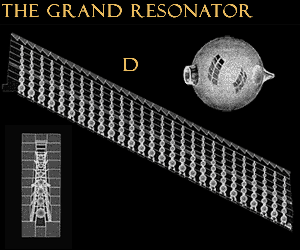
|
|
|
A "Helmholtz Resonator" (top right) is basically any hollowed-out object with a thin neck protruding from one side out of which sound
can travel. Sound is produced when the resonator is vibrated, either directly or sympathetically with a nearby resonator of the same
resonant frequency. The resonator can be tuned based upon the size of the object, the width and length of the neck, and so forth.
Dunn believes that the Grand Gallery, henceforth referred to as the "Grand Resonator" (D), was once
filled with 27 racks of these types of
resonators, 7 rows per rack, each row tuned to emit one note on a 7-note scale. All together, with the Grand Resonator providing the
high and midrange notes, and the Subterranean Subwoofer providing the the bass and sub-bass notes, the pyramid was one giant speaker
that "sang"
one massive chord in F-minor.
This chord was then directed into the King's Chamber where it was converted in piezoelectric
energy.
Images adapted from
The Giza Power Plant and
SciScape.org
|
|
To extrapolate further we could say that each resonator assembly that was installed in the Grand Gallery was equipped with several Helmholtz-type resonators that were tuned to different harmonic frequencies. In a series of harmonic steps, each resonator in the series responded at a higher frequency than the previous one. In a manner similar to the King's Chamber's response to energy inputs — its creation of an
F-Sharp chord
— these resonators raised the frequency of the vibrations coming from the Earth. To increase the resonators' frequency, the ancient scientists would have made the dimensions smaller, and correspondingly reduced the distance between the two walls adjacent to each resonator. In fact, the walls of the Grand Gallery actually step upward seven times in their height and most probably the resonators' supports reached almost to the ceiling. At their base, the resonators were anchored in the ramp slots. Not surprisingly, there is additional evidence in the Grand Gallery to support this premise, especially in a design feature of the gallery that is seldom given much thought. This is a groove, or slot, cut along the length of the second layer of the corbelled wall. This groove suggests the resonators were held in place inside the Grand Gallery and positioned, or keyed, into the structure by first being installed into the ramp slots and then held in a vertical position with "shot" pins in the groove. Once the resonator assemblies were positioned and locked into place, the angle of the slot effectively prevented them from moving.14
According to Dunn's theory, each of these racks, 27 in all, held 7 rows of Helmholtz Resonators, each of which emitted a tone equivalent to one step in the Egyptian
musical scale.
Though no one knows for sure what the Egyptian scale was, Dunn believes that the sound generated by the Subterranean Subwoofer and the Grand Resonator combined together played what we would now call an F-Sharp chord. Dunn arrived at this conclusion based on the fact that sound experiments proved that the King's Chamber — and indeed the entire Great Pyramid — is tuned to the F-Sharp chord. Dunn elaborates,
Subsequent experiments conducted by Tom Danley in the King's Chamber of the Great Pyramid and in the chambers above the King's Chamber suggest that the pyramid was constructed with a sonic purpose. Danley identifies four resonant frequencies, or notes, that are enhanced by the structure of the pyramid, and by the materials used in its construction. The notes from an F Sharp chord, which according to ancient Egyptian texts [are] the harmonic of our planet. Moreover, Danley's tests show these frequencies are present in the King's Chamber even when no sounds are produced. They are there in frequencies that range from 16 Hertz down to 1/2 Hertz, well below the range of human hearing. According to Danley, these vibrations are caused by the wind blowing across the ends of the so-called shafts — in the same way as sounds are created when one blows across the top of a bottle. Included in the program is a meeting with a Native American maker of sacred flutes from Oregon. His flutes which are made to serenade Mother Earth, are tuned to the key of F Sharp!15
Based upon Dunn's research, then, it appears that the "earth power" that was used to power the Giza Power Plant came in the form of seismic energy that was converted to sound through highly sophisticated architectural and musical means. This sound was carefully tuned so as to generate an F-Sharp chord, which, acoustically concentrated in the King's Chamber, caused the granite walls, floor, ceiling and sarcophagus in the King's Chamber to resonate. The quartz crystals that make up 50% of the structure of granite resonate at certain frequencies, and when they resonate they generate a form of electricity called
piezoelectricity,
so when the pyramid was in full swing, the entire King's Chamber must have contained a tremendous amount of electrical energy, ready to be put to use.
 H Y D R O G E N
H Y D R O G E N
The second element that Dunn proposes was necessary for the Giza Power Plant was hydrogen. He believes that the two shafts (B1 & B2) that lead to the so-called "Queen's Chamber" (B) were once used to feed hydrated zinc chloride and hydrochloric acid into the Queen's Chamber in order to provoke a chemical reaction that would result in the creation of pure hydrogen. He came to this conclusion due to the fact that the entire Queen's Chamber — walls, ceiling and floor, as well as the passageway that led to it — had been and still is covered in 1/2 inch of a salty material that is a combination of calcium carbonate (limestone), sodium chlorite (salt) and calcium sulfate (gypsum).
Some have speculated that this salty substance was a leftover from the Great Flood, which would have indeed flooded the Great Pyramid for a time if the tsunami had reached that far. However, they forget that the rest of the pyramid is salt-free, which negates that possibility. In fact, the only possible way that the walls, ceiling and floor of the Queen's Chamber could have been covered was if the salt had been deposited as a result of hot hydrogen reacting with the limestone walls. There is no other possible way, as the salty residue on the limestone walls could only have occurred as a result of a unique chemical reaction that can only be caused by hot hydrogen gas reacting with limestone. But by what means were the zinc chloride and hydrochloric acid piped into the Queen's Chamber and mixed? The answer is in fact very simple: the mysterious shafts that were found by the stonemason
Wayneman Dixon
in 1872. Dixon, when searching the walls of the Queen's Chamber for clues leading to other secret tunnels or chambers, chanced upon a couple of thin slits in the northern and southern walls of the Queen's Chamber. He set at the slits with hammer and chisel, and found that they were slits in a thin covering for two long shafts that were approximately 7" square and went far into the body of the pyramid.
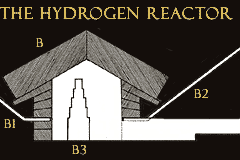
|
|
|
The "Queen's Chamber", which Christopher Dunn has demonstrated was more likely a chemical reaction chamber wherein hydrated zinc
chloride and hydrochloric acid were combined to create hydrogen. Evidence for such a reaction exists all over the walls, and ceiling
of the chamber, in the form of sodium chlorite, which would only have formed as a result of a chemical reaction between hot hydrogen
gas and the limestone walls of the chamber. Thus, a more likely name for it should be "the Hydrogen Reactor". The hydrated zinc
chloride and hydrochloric acid were piped in through the northern and southern shafts, (B1 & B2) their flow
controlled by various regulators (B3)
discussed at length by Dunn in The Giza Power Plant.
Another possibility discussed by Mehler in
The Land of Osiris
is that the Egyptians had mastered the technique of mixing hot and cold water (B1 & B2) in such a way as to
convert the water into hydrogen and oxygen in what he calls an "implosion reaction", the process perhaps initiated by some sort of
apparatus that was once located in the niche in the Queen's Chamber
(B3).
|
|
Over a century would pass until 1991, when a German engineer by the name of
Rudolf Gantenbrink
teamed up with the German Archaeological Institute to investigate the largely unexplored shafts in the King's and Queen's Chambers. The King's Chamber shafts (A1 & A2) had been found to lead to the outside of the pyramid, but they could not find the Queen's Chamber shafts' openings on the outside. As part of an agreement with the Egyptian authorities, Gantenbrink had agreed to clean out the King's Chamber's shafts of all the debris that had accumulated there, and to install a ventilation system to decrease the temperature and humidity within the pyramid that had been greatly elevated by the huge number of tourists within the pyramid.
Having completed this part of his task, Gantenbrink built a robot specially designed to measure and videotape the interior of both the King's Chamber and Queen's Chamber shafts. And in 1993, Gantenbrink successfully used a robot named "Upuaut II" to succesfully navigate the Queen's Chamber shafts, discovering in the process a mysterious door that terminated the shaft almost 200 feet into the body of the pyramid. Unfortunately, after the discovery of the door, there was a sudden deterioration in the relationship between Gantenbrink and the Egyptian authorities, and as a result, Gantenbrink became disheartened and abandoned the project.
Another decade slipped away until on September 17, 2002, the
Gantenbrink Door
was finally opened.
Unfortunately, nothing was found but a small space, after which another block of stone again blocked the passageway. Dunn had expected to see the passageway go downward into the body of the pyramid, where he believed there were pumps which would feed the zinc chloride and hydrochloric acid into the respective shafts, but no shafts or holes were immediately visible (though
later analysis
of the video by Christopher Dunn shows what may be a small hole in the terminus of the shaft). Unfortunately, we may not find the answer for another decade or more, or possibly much longer, due to the extreme restrictions that have been placed on archaeological excavation of the pyramid in recent years.
At any rate, Dunn's theory sounds plausible. We have seen that the Great Pyramid is essentially a gigantic speaker system tuned to generate an F Sharp chord, which in turn was directed into the all-granite King's Chamber. This resonating granite, which is made up of roughly 1/2 quartz crystals, then generated a great deal of piezoelectricity, a tremendous amount of potential energy just waiting to be released through some sort of medium. But what medium? Dunn believes that the hydrogen that was created in the Queen's Chamber, or "Hydrogen Reactor", filled the entire inside of the pyramid, particularly the King's Chamber, where it was propelled by the force of the sound waves. Dunn elaborates,
After transducing mechanical energy into electrical energy, there has to be a medium through which the electricity can flow and be utilized. In a modern power plant, steam passes across turbine blades causing rotation of a generator that stimulates electron flow through copper wires. In this power plant the vibrations from the Earth cause oscillations of the granite within the King's Chamber, and this vibrating mass of igneous, quartz-bearing rock influences the gaseous medium contained within the chamber. Currently this gaseous medium is air, but when this power plant operated, it was most likely hydrogen gas that filled the inner chambers of the Great Pyramid.16
But sound and hydrogen were only part of the equation. Dunn believes that an additional force was brought in in order to generate what modern science calls a MASER — Microwave Amplification through Stimulated Emission of Radiation. MASERs — a form of laser that utilizes microwaves as its power source, and hydrogen as its medium — can be produced by modern science with relative ease. But how on Earth, assuming the technological level of the antediluvian Egyptians was adequate to the task, could the Great Pyramid have been designed so as to capture or generate microwave energy?
 S O L A R & L U N A R E N E R G Y
S O L A R & L U N A R E N E R G Y
|
|
|
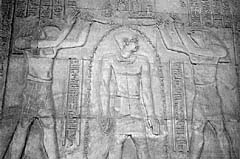
|
|
|
"The Two Waters" relief at Kom Ombo, in the Temple of Sobek-Horus. Here a pharaoh is depicted being anointed by two different
kinds of liquid — one from the solar principle, Horus (right), and one from the lunar principle, Thoth (left). Could this
have been a dim remembrance of times past when the power of the sun and the moon — and of water — were once harnessed to
generate powerful forces to serve the Pharaoh?
Image from
The Land of Osiris
|
|
Another anomaly of the Great Pyramid that rarely gets any attention is the fact that the outer faces are slightly concave — not easily noticeable, but definitely a distinct architectural feature that must have been intentional. Many have speculated on the reason, but none had come up with a logical answer — until now.
Dunn, in the process of theorizing what possible use a resonating granite chamber full of hydrogen might be good for came to the conclusion that it is useless unless there is some sort of method of drawing that energy outside of the pyramid so it could be put to use in some sort of application. Eventually he did come up with answer, an answer that solved the mystery of the King's Chamber, as well as a couple of other related mysteries that have baffled Egyptologists for over a century.
In order to create a MASER, one would have to create an environment of stimulated hydrogen, and then pass a directed beam of microwave energy through that medium, the result being a powerful beam of light with a great deal of energy. We have already determined that there was an environment of stimulated hydrogen in the King's Chamber, but how does the microwave radiation become introduced? Are there shafts in the King's Chamber like those in the Hydrogen Reactor, that could have been used to introduce radiation into the King's Chamber? In fact, like the Hydrogen Reactor, the King's Chamber — which we shall henceforth refer to as the "Power Center" — also has two shafts in its northern and southern walls. However, unlike the Hydrogen Reactor's shafts, which had been narrowed to slits purposely to help meter the amount of liquid that came through them, the Power Center's shafts were wide open. Also unlike the Hydrogen Reactor's shafts, the Power Center's shafts reached all the way to the outside of the pyramid. And therein lies our answer.
Another often overlooked fact about all three of the Giza pyramids is that they were all once covered by a layer of pure white "casing stones" that gave the pyramid a beautiful, smooth, highly reflective outer finish. Unfortunately, through earthquakes and plunder by local arabs, the casing stones have mostly been removed from the pyramids. As John DeSalvo of the Great Pyramid of Giza Research Association explains,
|
|
|
|
|
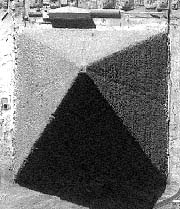
|
|
|
The Great Pyramid, unlike any other pyramid in the world, actually has sides that are slightly concave. This feature was probably
greatly exaggerated when the casing stones were still intact, where the southern and northern faces of the pyramid were shaped
like modern-day radio telescopes, complete with a collection point which then beamed the radiation down the northern and southern
shafts into the Power Center where it was converted into usable energy.
Image from
Catchpenny Mysteries of Ancient Egypt
|
The beautiful smooth blocks which covered the entire exterior, thus encasing the whole structure, became known as Casing Stones. At the present, only a few of these are left in position on each side at the base, most of the others having been stripped off by the Arabs and cut up to build mosques in Cairo. One of the largest remaining Casing stones is nearly 5 feet high by 8 feet at the bottom, and weighs about 14 tons.
Before the Arabs began to tear off the very beautiful casing stones about 600 years ago, it was magnificent to behold. The ancient writer,
Strabo,
said of the Great Pyramid, "It seemed like a building let down from heaven, untouched by human hands." It has been calculated that the original pyramid with its casing stones would act like gigantic mirrors and reflect light so powerful that it would be visible from the moon as a shining star on earth.17
The bright white casing stones would make an ideal reflector for both light and cosmic rays that hit Earth 24 hours a day. Yet our modern reflector telescopes have to be concave, curved like a dish, in order to reflect the light into a central focal point that then captures the radiation. Most people don't realize this, but the Great Pyramid is actually
concave
on all four sides — the only pyramid in the world that it like this. As such, Dunn argues, the Great Pyramid likely had collectors on its northern and southern faces that collected the solar energy by day, and the lunar energy — radiation from space, including reflected solar light off the lunar surface, and various other types of background radiation including microwaves — by night. Once again, Dunn had found the solution, and the concept of the Giza Power Plant was born.
 C R Y S T A L E N E R G Y
C R Y S T A L E N E R G Y
|
|
|
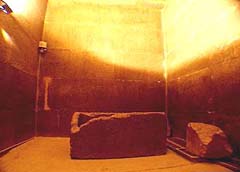
|
|
|
The interior of the King's Chamber, or "Power Center". According to Dunn's theory, microwave energy was piped into the Power Center
and through the "sarcophagus", which acted as a granite "lens" which focused the energy into a beam that
mixed with the energized hydrogen to form a MASER. The MASER then passed through the other side of the lens and into the southern
shaft, which led to the outside where the MASER was redirected to practical use. Our thesis, however, is that the energy was passed
into a crystal that then radiated energy outward, in function much like a Tesla Tower, but still one step away from becoming
fully functional.
Image from Guardian's Egypt
|
|
Though to this point I agree with Dunn's ideas almost without reservation, it is at this point where his theories and mine diverge as to
how the energy takes its final form. As we have seen, the interior of the King's Chamber, or "Power Center", was filled with hydrogen and
a deafening level of noise in the form of an F-Sharp chord, which vibrated the granite of the room and of the "sarcophagus", creating a powerful piezoelectric charge that energized the hydrogen and primed the room for the introduction of microwave energy in order to form a MASER. The microwave energy was piped in from the outside through the northern shaft, the opening of which can be seen on the right, above the rock. It then passed, according to Dunn's theory, through the "sarcophagus", that was actually just a granite "lens" that was used to focus the microwave energy into a beam that mixed with the energized hydrogen to form a MASER. The MASER then passed through the other side of the lens and into the southern shaft, which led to the outside where the MASER was redirected to practical use.
I differ here with Dunn on a couple of different points. First, I believe that both the northern and southern shafts were used to collect solar and lunar energy (as discussed previously), both of which fed into the Power Center, rather than energy entering one shaft and leaving another. Second, I believe that, instead of a MASER, the Power Center instead contained some kind of object that absorbed and transformed the enormous amounts of energy in the Power Center into a non-linear form that could be easily transmitted through the any medium with little or no attenuation whatsoever — like a Tesla Tower. This object was likely a large, specially designed quartz crystal or, as some have theorized, a device similar in size and function to the Ark of the Covenant that contained crystals. Fueling the latter theory is the fact that the Ark as described in the
Book of Exodus
would have fit nearly perfectly inside the granite sarcophagus. Moreover, Jewish tradition makes it clear that the
two tablets
of the Ten Commandments had been made of
sapphire,
a blue, transparent form of
corundum
that is crystalline in structure.
— Barring some new revelation, we will assume that this is indeed the answer — that inside the granite sarcophagus inside the Great Pyramid was once an antediluvian version of the Ark of the Covenant.
 T H E A N T E D I L U V I A N A R K O F T H E C O V E N A N T
T H E A N T E D I L U V I A N A R K O F T H E C O V E N A N T
|
|
|
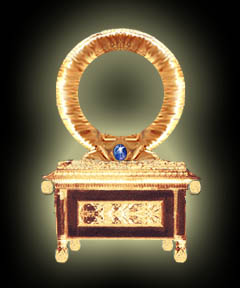
|
|
|
The Ark of the Covenant.
The size of the
Ark of the Covenant
given in the Book of Exodus fits nearly perfectly within the granite box
inside the King's Chamber of the Great Pyramid, leading some to speculate that Moses had actually taken the
ark
from the
Great Pyramid
as part of the spoils Israel had taken from Egypt. However, the Book of Exodus clearly describes the building of
the Ark of the Covenant, but it is likely they had gained the expertise for doing so during their sojourn in Egypt. Moreover, the
internal measurements
of the granite sarcophagus may be a little too narrow for the Hebrew Ark of the Covenant as described in the the
Book of Exodus, depending on the length of the
cubit employed.
("The True Ark" name and image © 2004
Doug Elwell, Inc. All Rights Reserved)
|
|
I disagree with Dunn's theory on the final form the energy took for a couple of reasons, the first reasons being practical ones. For one,
Dunn believes that the granite box in the Power Center acted as a lens for the incoming microwave radiation, but he overlooked one critical bit of information: the hole of the shaft is a few inches higher than the top of the box, so, his theory that the microwaves would hit the side of the box and pass through it is incorrect. As such, there must have been an object in the box, an object that protruded above the rim of the box so that the microwave and other energies being piped in from the northern and southern shafts would hit it.
The Ark of the Covenant would fit perfectly in the box, with the mercy seat protruding over the rim of the box, ready to receive the energies from the northern and southern shafts. In fact, if a
star sapphire
of the same type that is believed to have been used to create the two tablets of testimony (q.v.) was fitted in between the two cherubim, it would be at the perfect height to receive the energies from the northern and southern shafts, making it the place from which the "spark" that sets the rest of the machine in motion emanates. There was indeed an area between the cherubim on the mercy seat of the Ark of the Covenant that the high priest was to
sprinkle
|
|

|
|
|
A
star sapphire, which may have been set between the cherubim of the antediluvian ark, ready to receive the energy from the
northern and southern shafts. The
two tablets
of the Ten Commandments, according to Jewish tradition, were also carved from blue Sapphire stones. The two tablets were kept inside
the Ark of the Covenant at all times. Sapphire is
crystalline
in nature, and thus would resonate along with the granite structures within the Power Center. Once the ark was
installed in the Amplifier Cabinet (A3), the entire pyramid would be a massive amplifier for the already awesome power
of the Ark.
Image from Crystal Links
|
blood upon in order to propitiate the sins of the nation. And though its exact composition is unknown, it is not impossible that it, like the
tables of the testimony, was a star sapphire as well. In either case, the theory of an "antediluvian ark" or similar device that once graced the Power Center is probably the best one. The Ark of the Covenant
was an extremely powerful object on its own, so one can only speculate how much more powerful it would have become sitting at the center of the Great Pyramid, which might have multiplied its innate power by hundreds, even thousands of times.
One could even speculate that the entire pyramid may have been designed as an amplifier specifically for this antediluvian Ark. The Ark of the Covenant has often been described as having been designed as a powerful power condensor, and the gold of which it was made would have
made it a superior conductor of electricity, which many in the Old Testament found out the hard way. Moreover, Jewish legend describes Moses as having carved the two tablets of the Ten Commandments out of a
block of blue sapphire,
a crystalline stone that likely has resonant properties similar to that of the granite of the Power Center and of the granite box it was placed in (which we will henceforward refer to as the "Amplifier Cabinet" (A3)). As a result, the already powerful Ark, which was capable of destroying huge walls, levitation, and defeating entire armies could, when installed in the Great Pyramid, have become the ultimate weapon.
And there are not only practical matters to be considered before determining the final form of the power generated by the Great Pyramid. We must also consider some of the enigmatic statements made by the controversial "sleeping prophet", Edgar Cayce.
As we have seen,
|
|
|
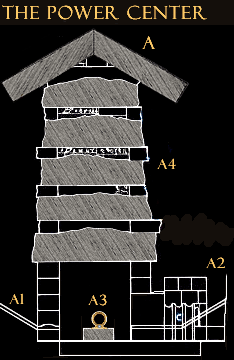
|
|
|
The "Power Center"(A), where everything came together. The F-Sharp chord generated by the Grand Resonator
(D) and the
Subterranean Subwoofer
(C)
was acoustically channeled into the Power Chamber, where is caused the granite to resonate.
The hydrogen generated by the Hydrogen Reactor
(B)
also filled the chamber, and became charged by the piezoelectric charge generated by the resonating granite. Solar energy by day and
lunar energy by night came in the northern and southern shafts
(A1 & A2),
transferring their power into the antediluvian Ark, which was placed in the Amplifier Cabinet
(A3).
The entire Power Center then became intensely charged with energy, which was broadcast by the crystals in the chamber and in the
Ark to the Super Directional Amplifiers
(A4)
above the main chamber of the Power Center. These chambers further amplified and aimed the power towards the top of
the pyramid, where it was received by the Transmitter.
Image from
Catchpenny Mysteries of Ancient Egypt
|
|
Cayce believed that the world before the Flood knew electricity, radio, television, nuclear power and even a currently unknown form of power that was based on crystals, tectonic "earth" power, and "cosmic rays", or electromagnetic radiation — including microwave radiation —
that we now know regularly bathes the earth from space. He also identified two groups of people, one good and one evil, whom he described as the sons of the Law of One and the sons of Belial, respectively. The sons of the Law of One had developed technology using earth energy, solar energy, lunar energy and crystals to use for man's benefit, whereas the sons of Belial — who are probably the wicked
giants
mentioned in the Bible and elsewhere — twisted that technology to use as a powerful weapon that they had tried to use to conquer the world.
In Cayce's visions, he describes the technology of the antediluvian world and how the sons of Belial had twisted it towards evil:
"In Atlantean land at the time of withdrawing from the Law of One � establishment of Sons of Belial � [the entity] was a priestess in temple built in opposition to the Sons of the Law of One � during time when there was the creating of the high influence of radial activity from rays of the sun that were turned on crystals in the pits that made connections with internal influences of the Earth."18 This, of course, is a perfect description of our new paradigm of the Great Pyramid of Giza as a power plant — the "rays of the sun" were channeled into the Power Center, where their power was greatly magnified by the crystals in the antediluvian Ark. Moreover, "internal influences of the Earth", seismic activity, were turned by the Great Pyramid into sound energy, which was channeled into the power center to generate huge amounts of electrical power. But perhaps the most important part of this vision is the fact that Cayce had been seeing through the eyes of a priestess of the wicked Belial faction that had built a temple like the Great Pyramid that they intended to use not as an inexhaustable supply of energy, but as a terrible weapon.

|
|
|

|
|
In the right hands, the Giza Power Plant was a tremendously beneficial asset to humanity. With relatively little effort, the Giza Power Plant — and others like it worldwide — provided humanity with almost unlimited free energy. And so, according to Cayce, for thousands of years the world was at peace, under the benevolent rule of the Children of the Law of One. However, the time came when the sons of Belial had gained the upper hand, and had turned the Giza Power Plant into a dreadful weapon:
The Giza Death Star.

How could the Giza Power Plant be turned into a "Death Star"? Let us first examine its normal functioning before we turn to any potential destructive applications. Once the Power Center had been powered up and working properly, the energy needed somewhere to go. Thus, the
|
|
|
|
|
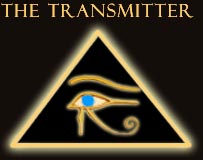
|
|
|
"The Transmitter" that once sat at the top of the pyramid. The energy from the Power Center was amplified and aimed by the
Super Directional Amplifiers (A4) upwards towards the peak of the pyramid, on which sat the Transmitter.
The Transmitter was likely composed of
one or more huge crystals, or perhaps another, much larger Ark-like apparatus. The intervening
limestone acted as a non-conductive element between the highly charged Power Center and Transmitter, so the entire mass of the
pyramid itself was (and is) basically a huge Ark, greatly amplifying the power of the antediluvian Ark by hundreds or thousands of
times. This power could then be broadcast through the huge Transmitter, which could be used to broadcast radio, television, electric
power or, if it fell into the wrong hands, death.
|
antediluvian Egyptians engineered the Power Center to have several levels of Super Directional Amplifiers (A4) above it that would both amplify and direct the energy upwards, towards the summit of the pyramid. There, the energy would hit the Transmitter, which was essentially a huge crystal or collection of crystals similar in function to the Ark but on a much larger scale, and with one major difference. On its lofty perch it could broadcast radio, television and/or power for hundreds of miles in any direction for use in any application. Not coincidentally, this is exactly how Cayce described the way it was done in the antediluvian world — using the mysterious "firestone" that could also broadcast radio, television and power through any medium:
About the firestone � the entity's activities then made such applications as dealt both with the constructive as well as destructive forces in that period. It would be well that there be given something of a description of this so that it may be understood better.... [The firestone was housed] in the center of a building which would today be said to be lined with nonconductive stone.... The building above the stone was oval; or a dome wherein there could be ... a portion for rolling back, so that the activity of the stars � the concentration of energies that emanate from bodies that are on fire themselves, along with elements that are found and not found in the Earth's atmosphere. The concentration through the prisms or glass (as it acted upon the instruments that were connected with the various modes of travel through induction methods which made much the [same] character of control as would in the present day be termed remote control through radio vibrations or directions; though the kind of force impelled from the stone acted upon the motivating forces in the crafts themselves. The building was constructed so that when the dome was rolled back there might be little or no hindrance in the direct application of power to various crafts that were to be impelled through space � whether within the radius of vision or whether directed under water or under other elements, or through other elements.... These, then, were impelled by the concentration of rays from the stone which was centered in the middle of the power station, or powerhouse (as would be the term in the present).19
As we have seen, the Transmitter was isolated from the Power Center by a large amount of non-conductive stone, just as the firestone was. Moreover, the heavenly bodies were also used in the Giza Power Plant to generate power, as had the firestone.
More importantly, Cayce describes that the energy that the firestone created, using, basically, energized quartz crystals, could be used for not only radio and television transmission, but also for power generation though any medium, at any distance. (Interestingly, this was essentially
Nicola Tesla's
goal also, before his mysterious death in 1943.)
In sum, the Great Pyramid was essentially a gigantic
Tesla Tower,
which radiated energy for general use throughout its radius of effect, and also functioned as a communications receiver and transmitter.
|
|
|
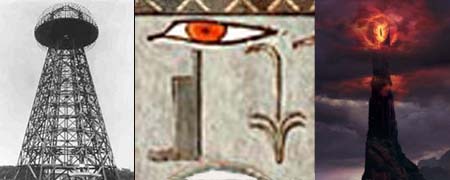
|
|
|
Left: Tesla's behemoth tower, to be used for trans-Atlantic wireless communications and the demonstration of wireless power
transmission, erected in 1901 at Wardenclyffe (now Shoreham) on Long Island.
Center: The hieroglyph for the Egyptian god Horus, which is simply the all-seeing eye over a throne. The plant to the right
was a later addition by the strange, superstitious religion of the dynastic Egyptians.
Right: The eye of Sauron — yet more evidence that J.R.R. Tolkien was a genius.
Sauron image from
The Art of the Return of the King
|
|

Unfortunately, the inevitable came, and the Great Pyramid was misused as a weapon of mass destruction. Regarding its usage as a "Death Star", Cayce painted a picture of dreadful awe and fear of what he called "the terrible mighty crystal" which, in the world before the Flood, had been use to cause great destruction:
In Atlantean land at time of development of electrical forces that dealt with transportation of craft from place to place, photographing at a distance, reading inscriptions through walls even at a distance, overcoming gravity itself, preparation of the crystal, the terrible mighty crystal, much of this brought destruction.... Before the second destruction when there was the dividing of the islands, when the temptations were begun in activities of Sons of Belial and children of Law of One. Entity among those that interpreted the messages received through the crystals and the fires that were to be the eternal fires of nature.20
As we saw in
Part III
in our series on Atlantis, the sons of Belial had destroyed most of Atlantis in a series of cataclysms that they had brought on themselves in their attempts to conquer the world. Though Cayce's description of how they had managed to sink the islands of Atlantis by their own actions is not clear, in the context of the Giza Death Star paradigm we can begin to see how this might have been accomplished. Essentially the sons of Belial had greatly ramped up the amount of power that could be output through the various power plants around the world by setting off explosions underground — nuclear explosions. As a result, the power output of the power plants such as the one at Giza were, for a short time, hugely increased as the seismic energy released by the nuclear weapon violently shook the pyramid. Unfortunately for the sons of Belial, these explosions also set off massive seismic disturbances which had the effect of sinking the island on which they were situated.

In his follow-up to The Giza Power Plant,
The Giza Death Star,
Joseph Farrell describes how the Great Pyramid had been turned into a terrible weapon in the wars that preceded the Great Flood:
From the sands of Egypt to the Indian subcontinent to the vitrified fortifications of northern Scotland, there are anomalous evidences that point not only to an enormous catastrophe that once beset the earth, but to a global war fought with weapons of mass destruction that may have triggered it. These anomalies form the scenery in which to view the workings and deployment of the Giza Death Star. They constitute compelling corroborative evidence that the Great Pyramid may once have been one of the weapons, perhaps the "Great Weapon" and "Great Affliction," whose deployment wrought such destruction and initiated such disasters.21
Farrell believes that not only was the Great Pyramid an integral part of the antediluvian war, it may have actually been the cause of the war. The existence of the pyramid and its immense potential for destruction must have presented such a threat to rival nations that they risked total destruction in order to neutralize it. And, if Farrell is right about its true potential for destruction, they were right to fear it. "My hypothesis [is] that the nuclear energy of the hydrogen plasma in the Great Pyramid was coupled to a superluminal "pilot wave" along with acoustic and electromagnetic energy and guided via harmonic interferometry to a target. The result ... would be an enormous thermonuclear and nuclear reaction in the target, regardless of the elements which composed the target.22
In short, the Giza Death Star was the ultimate weapon. Using the other two pyramids of the Giza complex to "aim" the energy, the antediluvian Egyptians could literally cause a nuclear explosion anywhere on Earth. Moreover, assuming that the weapon was indeed scalar in nature, as Tesla's experiments were, the energy would not travel line of sight, like a missile to a target, but would simply appear at the target instantaneously, causing a nuclear explosion, with no warning, and no possible defense — truly the ultimate weapon. If this is true, then it is no wonder that excavation in the Great Pyramid has been so severely restricted in recent years — it may well be that the Great Pyramid is the most powerful weapon ever made, of a technology that, if it fell into the wrong hands, could tip the balance of power so radically in favor of those who controlled it, that they could easily rule the world.




 Though the
antediluvian Athenians
did the majority of the fighting in the war against the Atlanteans, it appears that the antediluvian Egyptians actually may have been the true power of the region. The Great Pyramid had been developed initially as a tool for limitless power for improving the lifestyles of the antediluvian Egyptians, but it was eventually twisted by the giant sons of Belial into a weapon of unthinkable destruction. For this and many other reasons, it should come to no surprise that God ordered the destruction of the antediluvian world.
Though the
antediluvian Athenians
did the majority of the fighting in the war against the Atlanteans, it appears that the antediluvian Egyptians actually may have been the true power of the region. The Great Pyramid had been developed initially as a tool for limitless power for improving the lifestyles of the antediluvian Egyptians, but it was eventually twisted by the giant sons of Belial into a weapon of unthinkable destruction. For this and many other reasons, it should come to no surprise that God ordered the destruction of the antediluvian world.
The Great Pyramid was too complicated to have been thought of by man. It's dimensions, internal configuration and geometry speak loudly about the distinct possibility that its blueprint had been
stolen from heaven
itself, that in its near-flawless perfection it somehow resonates with higher realities, which may ultimately be the true source of its limitless power — power in the world before the Flood to create limitless energy, and power in modern times to create limitless fascination. Perhaps someday we will fully understand its purpose, but that understanding may come at a price, as we see the technology that was used to build the Great Pyramid misused once again in an attempt to conquer the world.
Until that time, we must be satisfied with the endless mystery that is Egypt. There is no shortage of ancient temples to explore, ruins whose origin and cause of destruction we can ponder, and mummies of ancient rulers whose thoughts and dreams we can only imagine. One thing appears to be becoming increasingly clear, however: ancient Egypt's most ancient history is not as it appears at first glance. The Egyptians of the dynastic period may not have founded Egypt, but merely rebuilt over and imitated the ruins of a much older civilization that existed there in the world before the Flood. Not knowing the true meaning of the fragments of history and technology that they had found in the aftermath of the antediluvian war and the Great Flood, they could not duplicate, merely imitate. Thus the pyramids that were built in the image of the Giza perfection looked like the Great Pyramid, but they were as dead inside as the Pharaohs that were buried in them. Perhaps someday mainstream Egyptology will accept the megalithic temples and structures such as the Great Pyramid for what they are — relics of the the world before the Flood — instead of what they want them to be. Until that time, we must continue searching on our own for the dream that was antediluvian Egypt. 
Part I: The Athenian Empire
|
Part III: Nimrod Hunting
|
Part IV: The Beast from the Sea
The Land of Osiris
|
The Antediluvian Egyptians
|
The Giza Power Plant
The Giza Death Star
|
A Canticle for Osiris
Osiria Links
|
Osiria Books
|
Osiria Audio
|
Osiria DVD
Editorial
|
Press Releases
|
Book Reviews
|
Fragments
Serpent Mound II
|
Giants II
|
Osiria II
Register
for our new Hall of Records Newsletter!
Questions? Comments? Suggestions? Advertising? Press Releases?
Contact us!

1
David Hatcher Childress,
Lost Cities of Atlantis, Ancient Europe & the Mediterranean
(Stelle, IL: Adventures Unlimited Press, 1996), 27.
2
Mysteries of Egypt,
"The Valley Temple"
(Mysteries of Egypt: http://www.ancient-mysteries.com).
3
Gary Fletcher,
"The Osireion"
(Ancient Civilizations - Tracing the Past: http://www.users.bigpond.com/MSN/gary_fletcher/).
4
David Hatcher Childress,
Technology of the Gods: The Incredible Sciences of the Ancients
(Kempton, IL: Adventures Unlimited Press, 2000), 11-12.
5
Christopher Dunn,
The Giza Power Plant
(Rochester, VT: Bear & Company), 232.
6
Stephen Mehler,
The Land of Osiris
(Kempton, IL: Adventures Unlimited Press), 161.
7
Edgar Evans Cayce,
Edgar Cayce on Atlantis
(New York: Warner Books, 1968), 85-86.
8
Childress,
Technology of the Gods, 213-214.
9
James Hartman,
"Flying Aircraft and Nuclear War and Other Strange Occurences of the Past
"
(Internet Text Archive: http://www.sacred-texts.com).
10
James Hartman,
"Ancient City Found In India Irradiated By Nuclear Blast 8,000 Years Ago..."
(Rense.com: http://www.rense.com).
11
Graham Hancock and Robert Bauval,
The Message of the Sphinx
(New York: Crown Publishers, 1996), 101-104.
12
Dunn,
The Giza Power Plant, 144.
13
Dunn,
The Giza Power Plant, 144-145.
14
Dunn,
The Giza Power Plant, 166.
15
Dunn,
The Giza Power Plant, 139-140.
16
Dunn,
The Giza Power Plant, 179.
17
John DeSalvo,
"A Picture Tour of the Great Pyramid of Giza"
(Great Pyramid of Giza Research Association: http://www.gizapyramid.com).
18
Cayce,
Edgar Cayce on Atlantis, 74.
19
Cayce,
Edgar Cayce on Atlantis, 88-89.
20
Cayce,
Edgar Cayce on Atlantis, 87.
21
Joseph P. Farrell,
The Giza Death Star
(Kempton, IL: Adventures Unlimited Press, 2001), 19.
22
Farrell,
The Giza Death Star, 23.




 Plato: Timaeus & Critias
Plato: Timaeus & Critias
 University of Iowa: Briefing on Lost Continents
University of Iowa: Briefing on Lost Continents
 Washington State University: The Athenian Empire
Washington State University: The Athenian Empire

 Mysterious World: The Riddle of the Sphinx
Mysterious World: The Riddle of the Sphinx
 TourEgypt.net
TourEgypt.net
 TourEgypt.net: "The Great Sphinx"
TourEgypt.net: "The Great Sphinx"
 TourEgypt.net: "The Temples of Ancient Egypt"
TourEgypt.net: "The Temples of Ancient Egypt"
 TourEgypt.net: "The Pyramids of Ancient Egypt"
TourEgypt.net: "The Pyramids of Ancient Egypt"
 Guardian's Egypt: Guardian's Sphinx: Guardian of the Horizon
Guardian's Egypt: Guardian's Sphinx: Guardian of the Horizon
 Guardian's Egypt
Guardian's Egypt
 Egyptsites
Egyptsites
 Mysteries of Egypt
Mysteries of Egypt
 Eridu.co.uk: Egypt
Eridu.co.uk: Egypt
 Nova Online: Pyramids
Nova Online: Pyramids
 aiwaz.net_institute: Giza & Great Pyramid
aiwaz.net_institute: Giza & Great Pyramid
 aiwaz.net_institute: The Missing 14th Piece of Osiris
aiwaz.net_institute: The Missing 14th Piece of Osiris
 University of Michigan Virtual Reality Modeling Language: The Great Pyramid of Khufu
University of Michigan Virtual Reality Modeling Language: The Great Pyramid of Khufu
 National Geographic: Egypt
National Geographic: Egypt
 Egypt Loves You: Sounds from the Great Pyramid
Egypt Loves You: Sounds from the Great Pyramid
 The Oriental Institute: The Giza Plateau Mapping Project
The Oriental Institute: The Giza Plateau Mapping Project
 Civilization.ca: Mysteries of Egypt
Civilization.ca: Mysteries of Egypt
 BBC History: Egypt
BBC History: Egypt
 Lost Civilizations Uncovered: Who Built the Great Pyramid?
Lost Civilizations Uncovered: Who Built the Great Pyramid?
 The Seven Wonders of the Ancient World: The Great Pyramid of Giza
The Seven Wonders of the Ancient World: The Great Pyramid of Giza
 Magical Places: Egypt
Magical Places: Egypt
 Virtual Egypt
Virtual Egypt
 Great Pyramid of Giza Research Association
Great Pyramid of Giza Research Association
 Philosophical Research Society: Gallery of Egyptian Mysteries
Philosophical Research Society: Gallery of Egyptian Mysteries
 University of Michigan Virtual Reality Laboratory: The Great Pyramid of Khufu
University of Michigan Virtual Reality Laboratory: The Great Pyramid of Khufu
 Cosmo Player plug-in
Cosmo Player plug-in
 Great Pyramid Measurements
Great Pyramid Measurements
 The Great Pyramid Institute
The Great Pyramid Institute

 Osiris
Osiris
 Pharaoh Khufu
Pharaoh Khufu
 Pharaoh Khafre
Pharaoh Khafre
 Pharaoh Menkaure
Pharaoh Menkaure
 Zahi Hawass
Zahi Hawass
 John Anthony West
John Anthony West
 Robert Schoch
Robert Schoch
 Robert Bauval
Robert Bauval
 Graham Hancock
Graham Hancock
 Christopher Dunn
Christopher Dunn
 Joseph Farrell
Joseph Farrell

 EgyptianMyths.net: Osiris
EgyptianMyths.net: Osiris
 University of Colorado: Osiris
University of Colorado: Osiris
 EgyptianMyths.net: The Story of Isis and Osiris
EgyptianMyths.net: The Story of Isis and Osiris
 TourEgypt.net: Osiris, Asar
TourEgypt.net: Osiris, Asar
 Ohio State University: Osiris
Ohio State University: Osiris
 EgyptianMyths.net: Horus
EgyptianMyths.net: Horus
 EgyptianMyths.net: Shu
EgyptianMyths.net: Shu
 EgyptianMyths.net: Tefnut
EgyptianMyths.net: Tefnut
 EgyptianMyths.net: Ptah
EgyptianMyths.net: Ptah
 Mythweb: Hephaestus
Mythweb: Hephaestus
 The goddess Athena: Athena
The goddess Athena: Athena


 Lost Cities of Atlantis Ancient Europe & the Mediterranean
Lost Cities of Atlantis Ancient Europe & the Mediterranean
(Lost Cities Series)
David Hatcher Childress
Rating:    
One of Childress' popular "Lost Cities" series, Lost Cities of Atlantis Ancient Europe & the Mediterranean covers the region in and around the Mediterranean Sea, with a special emphasis on cities and mysteries submerged beneath the waters of this vast inland sea. Calling himself a "maverick archaeologist", Childress is more of a researcher, historian, travel writer, and general raconteur rather than a a true academic archaeologist, making general observations based upon library research, study of local myths, legends, and personal anecdotes, as well as actual experiences visiting these sites. Childress is part of a growing trend in historical and archaeological studies towards the rise of independent researchers. These independents are men and women who have developed a distrust for "mainstream" academic archaeology, due to the fact that there is increasing evidence that the academic community is dismissing, ignoring, or even suppressing archaeological evidence that does not fit in with their preset theories. As a result, these independents have dismissed academe as largely irrelevant, and have gone out on their own to examine the evidence for themselves, usually at their own time and expense. It was this kind of passionate search for the truth about history and our origins that motivated similar men of the 19th century to develop the science of archaeology, a passion that motivated people of the 20th century like Childress, unsatisfied by the condescending, pat answers of academics, to take matters into their own hands. Now, in the 21st century, a growing chorus of discontentment with the academic archaeological establishment continues to erode their viselike grip on the truth of our origins, and the independents stand poised to wrest the sword of truth from the hands of those who seem only to be concerned about personal power, privilege, and social status. Lost Cities of Atlantis, Ancient Europe & the Mediterranean is a fascinating read, and a good addition to the Lost Cities series. It should make a great traveling companion for anyone traveling in the Mediterranean region, as well as a cracking great read for the armchair archaeologist, or just someone who enjoys ancient history and mysteries.
Click
here
to buy this book.
 Underworld: The Mysterious Origins of Civilization
Underworld: The Mysterious Origins of Civilization
Graham Hancock
Rating:     
From the author of the bestselling Fingerprints of the Gods comes a fascinating voyage of underwater discovery that will forever change the way we think about the birth of civilization. Fans of
The Sign and the Seal
and
Heaven�s Mirror
will delight in Graham Hancock�s Underworld, his latest work of archaeological detection. In this mesmerizing book, Hancock merges cutting-edge science with historical myth to come up with a new explanation for the origins of civilization as we know it today. At the end of the last Ice Age melting ice caused sea levels around the world to rise by approximately 400 feet, radically changing the shape of the world. Hancock, steeped in the ancient flood myths that speak of early civilizations, sets out to discover whether these myths have any basis in reality. Using the latest computerized "inundation maps" that show the shape of the world�s coastlines as they looked at intervals throughout the meltdown, Hancock finds astonishing correspondences with the ancient flood myths. And, when he starts to explore these areas underwater on several diving expeditions, he actually discovers ruins beneath the sea exactly where the myths say they should be. Hancock offers dramatic accounts of his explorations of the waters of the Arabian Sea, the Mediterranean, and the sea of Japan. This entertaining and provocative book of discovery presents the first hard evidence of these ancient cities, and gives all of us stunning insight into the origins and development of civilization.
(Review by Amazon.com)
Click
here
to buy this book.
 The Message of the Sphinx:
The Message of the Sphinx:
A Quest for the Hidden Legacy of Mankind
(1997)
Graham Hancock, Robert Bauval
Rating:
    
A provocative new approach to Egyptology argues that the ancient
structures at Giza may be much older than originally thought and that their
alignment may be a cryptic message directed toward a mysterious underground chamber
recently detected beneath the Sphinx. In this riveting account of historical and
archaeological investigation, the authors present hard evidence that the Sphinx, the
Pyramids, and the other monuments at Giza are of far more ancient origin than previously
believed. Complete with evidence of a conspiracy between the Egyptology establishment
and various confidential organizations to keep the secrets of the Pyramids from the world,
The Message of the Sphinx is also a modern-day detective story. This popular book has
received many good reviews, and is personally recommended by the publisher.
Click
here
to buy this book.
 The Orion Mystery:
The Orion Mystery:
Unlocking the Secrets of the Pyramids (1995)
by Robert Bauval, Adrian Gilbert (Contributor), Peter Ginna (Editor)
Rating:
    
This fascinating archaeological detective story argues that the great pyramids
of Egypt's Fourth Dynasty (c. 26002400 b.c.) were vast astronomically
sophisticated temples, rather than the pharaonic tombs depicted by
conventional Egyptology. Mysterious airshafts, which lead from the Great Pyramid's
chambers to its exterior were sited, the authors argue, to coincide with the key stars of
Orion, a constellation that had religious significance for the Egyptians. Using
astronomical data about stellar movement, they argue that the Orion stars
coincide exactly with the pyramids' positions in approximately 10,400 b.c.--a
period the Egyptians called the First Time, when they believed the god Osiris
ruled the Earth. This excellent book makes a good companion volume to Hancock's
"The Message of the Sphinx", which it preceded.
Click
here
to buy this book.
 The Serpent in the Sky:
The Serpent in the Sky:
The High Wisdom of Ancient Egypt
(1993)
John Anthony West
Rating:
   
This revised edition of West's revolutionary reinterpretation of the civilization of Egypt
challenges all that has been accepted as dogma concerning this ancient and enigmatic
land. It features a new introduction linking Egyptian science with the perennial wisdom
tradition and an appendix updating the author's work in redating the Sphinx.
Illustrations.
Click
here
to buy this book.
 The Egyptian Book of the Dead: The Book of Going Forth by Day
The Egyptian Book of the Dead: The Book of Going Forth by Day
The Book of the Dead is a collection of writings that were placed in tombs as a means of guiding the ancient Egyptian soul on its journey to the afterlife. The Papyrus of Ani, which is reproduced here, is one of the most important and beautiful of the surviving papyri. Damage in the 19th century seriously confused its sequencing and the relationship between text and illustrations. Here for the first time the scroll is presented in its proper sequence and in its entirety. The English text is placed immediately underneath the corresponding hieroglyphs, and the reproductions are faithful to the originals in all their glowing color. A critical purchase for any serious collection of materials on ancient Egypt.
Click
here
to buy this book.
 Riddles of the Sphinx (1998)
Riddles of the Sphinx (1998)
Paul Jordan, John Ross (Photographer)
Rating:
    
This book tells the full story of the Great Sphinx of Giza as Egyptology has
uncovered it. The Sphinx is one of the most striking monuments of the ancient
Egyptians, and has attracted the attention of travellers, scientists, archaeologists
and others for generations. Paul Jordan details the Sphinx's impact on the
ancient world, on Arab writers, on Renaissance travellers, on the pioneers of
Egyptology and on modern scholarship. He tells the story of the Sphinx's many
bouts of excavation and restoration, and above all puts the Sphinx in the
context of all that is known about ancient Egyptian history and religion. This
book examines every aspect of the Sphinx, including a professional geologist's
recent claims regarding its age, and provides an authoritative and highly
readable overview of the issues and debates currently surrounding it.
Click
here
to buy this book.
 The Complete Temples of Ancient Egypt
The Complete Temples of Ancient Egypt
Richard H. Wilkinson
Paul Jordan, John Ross (Photographer)
Rating:
    
Following the format of other "Complete" books in Thames & Hudson's informal series, Wilkinson, director of the University of Arizona's Egyptian Expedition and coauthor of The Complete Valley of the Kings, pulls together a huge amount of data to give a clear and concise look at the development, rise, decline, and excavation of Egyptian temples. His coverage ranges from the earliest predynastic sites to Roman, Christian, and Islamic adaptations of the temples. When theories are in dispute (as they often are), Wilkinson says so and then explains his preference. The illustrations, elevations, plans, and reconstructions make even the most complicated temple plans clear. An indispensable work for a student of Egyptian life or architecture, this unique and excellent resource is essential for large high school and all public, academic, and specialized libraries.
Click
here
to buy this book.
 The Complete Pyramids: Solving the Ancient Mysteries
The Complete Pyramids: Solving the Ancient Mysteries
Mark Lehner, Richard H. Wilkinson
Rating:
    
Archetypal symbols of remote antiquity, the pyramids have for centuries inspired passionate theories about their origins, purpose, and method of construction. Now, in the first fully illustrated compendium of every major pyramid of ancient Egypt, Mark Lehner, a leading Egyptologist, surveys the history, building, and use of the pyramids in unprecedented detail. 450 illus. 100 in color.
Mark Lehner, a leading Egyptologist, directed the Sphinx and Isis Temple Project from 1979 to 1983; since 1984 he has been director of the Giza Plateau Mapping Project. He is visiting Assistant Professor at the Oriental Institute, University of Chicago, and a Research Associate at the Harvard Semitic Museum.
Click
here
to buy this book.
 The Land of Osiris
The Land of Osiris
Stephen S. Mehler
Rating:
   
Egyptologist Stephen S. Mehler has spent over 30 years researching the answers to these questions:
 Was there a advanced prehistoric civilization in ancient Egypt?
Was there a advanced prehistoric civilization in ancient Egypt?
 Who were the people who built the great pyramids?
Who were the people who built the great pyramids?
 Who carved the Great Sphinx?
Who carved the Great Sphinx?
 Did the pyramids serve as energy devices and not as tombs for kings?
Did the pyramids serve as energy devices and not as tombs for kings?
Mehler believes the answers are "Yes!" An indigenous oral tradition still exists in Egypt, he has been able to uncover and study it with the help of a living master of this tradition, Abd'El Hakim Awyan. He has also been given permission to share these teachings — presented heretofore in fragments by other researchers — to the Western world, teachings that unfold a whole new understanding of ancient Egypt.
(Review by Amazon.com)
Click
here
to buy this book.
 Technology of the Gods: The Incredible Sciences of the Ancients
Technology of the Gods: The Incredible Sciences of the Ancients
David Hatcher Childress
Rating:
   
Technology of the Gods lays out the mind-bending evidence that long-lost civilizations had attained and even exceeded our "modern" level of advancement. Westerners have been taught that humankind has progressed along a straight-line path from the primitive past to the proficient present, but the hard, fast evidence (literally written in stone!) proves that the ancients had technologies we cannot even replicate today. Popular Lost Cities author David Hatcher Childress takes us into the amazing world of ancient technology, exploring the astounding structures built by the megalithic masterminds, and examining all kinds of impossible artifacts. He discusses the use of crystal lenses and the "fire from the gods" in both ancient religious ceremonies and warfare. He recounts tales of ancient flight, and presents the archaic documents that describe the technology. Was the Great Pyramid of Egypt originally a gigantic power station? Was the Ark of the Covenant an electrical device? Has mankind teetered on the brink of atomic destruction in the past, and in fact, fallen over the edge? Examine the eye-popping evidence that the ancients actually destroyed their extraordinary culture themselves! (From the back cover)
(Review by Amazon.com)
Click
here
to buy this book.
 The Giza Power Plant
The Giza Power Plant
Christopher P. Dunn
Rating:
    
Suspicion naturally arises when you read a promo line on a back cover that says, "This is the most important book concerning the Great Pyramid written in the last 20 years." In this case, however, it may be fact. In writing The Giza Power Plant, mechanical engineer Christopher Dunn reverse-engineered the Great Pyramid at Giza to discover its use. His startling conclusions blow the heck out of traditional Egyptology's rather silly notions that it was built with copper tools by a society that lacked the wheel. While revisionist pyramid studies are rife with ridiculous theories that give the topic a bad name, The Giza Power Plant takes into account existing fact and artifact without having to rely on unprovable assertions. A must-read for truth seekers who aren't afraid to consider the idea that Western culture of the 21st century may not be the pinnacle of human evolution and achievement.
(Review by Amazon.com)
Click
here
to buy this book.
 The Giza Death Star
The Giza Death Star
Joseph P. Farrell
Rating:
   
Farrell theorized that the Great Pyramid was a terrible weapon of mass destruction, used by by a technological advanced ancient civilization in the mist of pre-history and sets today on the Giza Plateau disarmed but ready!
Farrell's technical civilization is the 'doner' civilization that provided the foundation of the Egyptian civilization that existed in the Nile Valley some 5,000 years ago.
What kind of civilization would have designed and built such an awsome weapon of mass destruction as envisioned by Farrell, and apparently used it with no hesitation against their fellow man? A civilization not unlike those that arose from the foundations and ashes of older extinct civilizations. A civilization subject to all the faults and foibles of human beings, hatred, love jealously and greed. No different than those in existance today and poised to destroy the world.
Farrell speculates, the "Great Pyramid was a phase congugate mirror(magic mirror of legends),and howitzer, utilizing Bohm's 'pilot wave' as a carrier to acelerate electromagnetic and acoustal waves to a target via harmonic interfermetry." Ferrell believes that the chambers and passageways of the Great Pyramid were used as a series of loops to generate and amplify these gravito-acoustical waves and direct them to their target.
Farrell finds traces of this ancient science he calls "Paleophysics" in the ancient and obsecure texts of Egypt.
If Ferrell's asumptions are correct, this ancient weapons system was the most powerful weapon ever to exist on Earth. Even today, with our advanced technology, the technology involved in the building of this weapon system can only exist in dreams. This is the grist for the mills of science fiction that dream of the theories of Nikola Tessla, The Montouk Project, the Philadelphia Experiment, and Area 51. These are the technologies our government is allways accused of developing in secret laboratories and witholding from the public.
After reading the "Giza Death Star", readers will never be able to look at the Giza Plateau and its mysterious pyramids and buildings in the same old way!
After reading the "Giza Death Star", find a copy of Hamlet's Mill and read it with a critical eye.
Sleep well tonight, keeping in mind that a government scientist in a weapons laboratory at an isolated location may be reading these same works!
(Review by Amazon.com)
Click
here
to buy this book.
 The Giza Death Star Deployed
The Giza Death Star Deployed
Joseph P. Farrell
Rating:
   
"The Giza Death Star Deployed" will completely change the way you think about ancient (pre-flood?) history. Though Mr. Farrell failed to convince of the fact that the Great Pyramid of Giza was necessarily a weapon, I am completely convinced that it was not built as a tomb. Joseph Farrell examines all the evidence, archaeological, historical, literary, and scientific, leaving no stone unturned. When I first picked up the book, I thought, as anyone would, "is he serious?". But even scanning through the book, I could tell that he was. Suffice it to say that you will never think of the pyramids of Giza the same. For a fresh look at ancient history (along with much, much more) read this book. (Review by Amazon.com)
Click
here
to buy this book.
 The Art of The Return of the King (The Lord of the Rings)
The Art of The Return of the King (The Lord of the Rings)
Gary Russell, Peter Jackson
Rating:
    
With Peter Jackson's Acadamy Award-winning epic motion picture trilogy drawing to a spectacular and triumphant close, Gary Russell's detailed research takes us back into the world of Middle-earth, to relive all the visual drama and excitement of The Return of the King.
The Art of The Return of the King illustrates the creative development of the film from sketch to special effect and features 600 images, most appearing nowhere else. This fully authorized book includes pencil sketches by Alan Lee and John Howe, costume designes by Ngila Dickson, magnificent full-color paintings by Jeremy Bennett, and prop designs, concepts, sculptures and digital artwork from Weta Workshop and Weta Digital. From Minas Tirith to Mount Doom, from the Army of the Dead to Shelob the monstrous spider, all the spectacular landscapes, characters and creatures are covered in stunning detail, including concepts that did not make it into the final film.
To accompany this wealth of imagery, detailed and informative commentaries appear by all the featured artists and designers, together with a special afterword by Peter Jackson. Their personal thoughts and explanations offer unique and fascinating insight into how The Return of the King was brought to life. An artistic journey begun in 1997 reaches its glorious conclusion within these pages, giving the reader a unique chance to witness the creative process that led to one of the most spectacular movies of all time. (Review by Amazon.com)
Click
here
to buy this book.
 A Canticle for Leibowitz
A Canticle for Leibowitz
Walter M. Miller Jr.
Rating:
   
Walter M. Miller's acclaimed SF classic A Canticle for Leibowitz opens with the accidental excavation of a holy artifact: a creased, brittle memo scrawled by the hand of the blessed Saint Leibowitz, that reads: "Pound pastrami, can kraut, six bagels--bring home for Emma." To the Brothers of Saint Leibowitz, this sacred shopping list penned by an obscure, 20th-century engineer is a symbol of hope from the distant past, from before the Simplification, the fiery atomic holocaust that plunged the earth into darkness and ignorance. As 1984 cautioned against Stalinism, so 1959's A Canticle for Leibowitz warns of the threat and implications of nuclear annihilation. Following a cloister of monks in their Utah abbey over some six or seven hundred years, the funny but bleak Canticle tackles the sociological and religious implications of the cyclical rise and fall of civilization, questioning whether humanity can hope for more than repeating its own history. The author explores the "sacralization" of knowledge in the absence of science. The Abbey's prized artifacts are the blessed blueprint, the sacred shopping list and the holy shrine of Fallout Shelter. The monks have very little idea as to the meaning of these writings and artifacts, but nonetheless make it their lives' work to preserve them as sacred items for some future time when they may be understood. The implication is that ancient writings considered sacred by religion are merely not well understood today and that, given sufficient knowledge, could become demystified commonplaces of natural science at some point in the future. (Review by Amazon.com)
Click
here
to buy this book.

 Raiders Of The Lost Ark [SOUNDTRACK]
Raiders Of The Lost Ark [SOUNDTRACK]
John Williams
Rating:     
The first of the three Indiana Jones scores, Raiders established the popular Raiders March Theme as an instant classic in the world. As easily recognizable as the Star Wars fanfare, John Williams' Raiders March is the first track on this expanded edition of the Raiders soundtrack, from there it becomes a great thrillride that follows Indy's adventures to find the Ark. Along with the standard music there are some bonus tracks that were not previously published before. The insert has an interview with John Williams, pictures from the making of the movie and a break down of the tracks. This is a superior soundtrack recording and unlike the more mature sound to Indiana Jones and the Last Crusade, has many more instances where the Raiders March is used. Other themes to listen for include the ark theme, which makes a brief reappearance in Last Crusade, is used many times here as well as the love theme for Indy and Marion.
1995 reissue. 30 additional minutes have been interwoven which were deleted from the original 1981 release, totaling 74 minutes of pure listening pleasure. Re-mastered including a special 24 page booklet containing an interview with John Williams, as well as liner notes, rare photos and sketches not included with the original release. Standard jewel case housed in a slipcase. Top notch.
Click
here
to buy this book.
 Beauty in the Beast
Beauty in the Beast
Wendy Carlos
Rating:     
From the roar of Tibetan horns and the clangor of metal percussion that opens Beauty in the Beast, Wendy Carlos in 1986 signaled a new direction for her music. Beauty in the Beast is Carlos's magnum opus, an album that should have established the synthesizer's role in the new global music landscape. More than that, it should have established Carlos as a composer and not just a Switched-on Bach jukebox. But not too many people were listening. Rereleased now after 14 years, Beauty in the Beast has lost none of its power. Carlos is both profound and poignant, dissonant and disarming on Beauty, as she fuses a global orchestra from her synthesizers. "Poem for Bali" is the centerpiece of the album, an episodic, 17-minute excursion as Carlos orchestrates the sounds and rhythms of a digital gamelan orchestra. In addition to replicating the metallophones, gongs, and flutes of the traditional gamelan, she creates her own hybrid sound designs, giving this work a surreal and sometimes harrowing tone, like a dream bent through funhouse mirrors. But then there are pieces such as "A Woman's Song," based on a Balkan melody. The title track merges nightmare landscapes and a crazed carnival calliope with a haunting theme that sounds like a lament for the end of the world. Beauty in the Beast is an essential recording of both modern composition and synthesis--Carlos should plug into this circuit again.
Click
here
to buy this book.
 Passion: Sources
Passion: Sources
Peter Gabriel/Realworld Music
Rating:
   
This excellent CD is a compilation of much of the source recordings that Peter Gabriel
used for Passion (above). A must-have for lovers of world music, especially African and
Middle-Eastern music.
Click
here
to buy this music.
 The Musicians of the Nile: Luxor to Isna
The Musicians of the Nile: Luxor to Isna
Musicians of the Nile
Rating:
   
Life in the villages spread out along the Nile hasn't changed in a thousand years; nor
for that matter has the traditional music of the region which has remained impervious to
outside influences, even Islamic ones. The recordings here weren't collected on site but
captured live at a Paris concert and in Real World's own studios in darkest Wiltshire.
No concessions are made to Western ears, however, other than upping the playback
quality of the intricate tabla rhythms as they tangle with ancient instruments like the
rababa, the droning oboe-like mizmar and the flutish arghul which goes all the way
back to the Pharaohs. Not so much a record, more like an adventure in sound. This
soundtrack is highly recommended by the publisher.
Click
here
to buy this music.
 Dark Side of the Moon 30th Anniversary Edition
Dark Side of the Moon 30th Anniversary Edition
Pink Floyd
Rating:
    
Dark Side of the Moon, originally released in 1973, is one of those albums that is discovered anew by each generation of rock listeners. This complex, often psychedelic music works very well because Pink Floyd doesn't rush anything; the songs are mainly slow to mid-tempo, with attention paid throughout to musical texture and mood. The sound effects on songs like "On the Run," "Time" and especially "Money" (with sampled sounds of clinking coins and cash registers turned into rhythmic accompaniment) are impressive, especially when we remember that 1973 was before the advent of digital recording techniques. This is probably Pink Floyd's best-known work, and it's an excellent place to start if you're new to the band.
Click
here
to buy this music.
 Eye in the Sky
Eye in the Sky
Alan Parsons Project
Rating:
   
Alan Parsons Project's Eye in the Sky was almost guaranteed at least moderate success due to the hits that preceded it ("Games People Play" and "Time" from Turn of a Friendly Card.) With Eye, Parsons returned in some ways to his more progressive, art-rock past and the album only had one major hit, the lush title track. Parsons's approach was a synthesis of studio wizardry with a symphonic, spacey interplay between keyboards, synthesizerss and basic rock instrumentation. Though never a hit, "Psychobabble" remains a favorite of fans. "Children of the Moon," "Sirius," and "Gemini" all have Parsons's love of the esoteric. "Mammagamma" also allowed Parsons to fully indulge his fondness for orchestration with its instrumental structure.
Click
here
to buy this music.

 Doctor Who: Pyramids of Mars (VHS)
Doctor Who: Pyramids of Mars (VHS)
(1975)
Rating:
    
In perhaps the greatest
Doctor Who episode
ever, the Doctor (played by Tom Baker) once again finds himself mysteriously caught up in the middle of a situation which, if not resolved, could lead to the eventual destruction of the universe. And though just about every other Doctor Who plot somehow involves the Doctor saving the universe from certain destruction, this time there is a real sense of menace as the Doctor finds himself squared off against one of the elder gods of Egypt — Sutekh, the Destroyer. Sutekh, coldly enunciated by Gabriel Woolfe, is easily the most menacing villain ever to appear in any Doctor Who episode. Interestingly, the
Viking Mission which took the images of the infamous face and pyramids on Mars did not reach Mars until 1976, a year after this episode aired.... (Review by Mysterious World)
Click
here
to buy this video.
 The Mystery of the Sphinx (VHS)
The Mystery of the Sphinx (VHS)
(1993)
John Anthony West, with Robert Schoch
Rating:
    
Click
here
for a sound sample!
The Mystery of the Sphinx contains information about the Sphinx, and Egyptian history and
archaeology in general, that is nothing less than explosive. John Anthony West and Robert
Schoch offer brilliant and convincing evidence that the Sphinx is much older than the
pyramids, possibly as much as 8,000 years older than previously thought, indicating that
our understanding of Egyptian history and religion has barely scratched the surface. Their
convincing testimony is made all the more interesting and entertaining by the inclusion
of Charlton Heston as the narrator. And this video is not merely a visual montage of Egyptian
images overlaid with mystical-sounding rhetoric. This is real science and real history -
and maverick archaeology at its best. This popular video is highly recommended by the
publisher. (Review by Mysterious World)
Click
here
to buy this video.
 Star Trek - The Original Series
Star Trek - The Original Series
Elaan of Troyius/ The Paradise Syndrome
(1966)
Rating:
   
In Episode 58 of the original series, "The Paradise Syndrome", Kirk, Spock and McCoy beam down to a remarkably earthlike planet that is about to be destroyed by a massive asteroid in an attempt to save some of the inhabitants. While on the surface, they find a strange, alien device shaped like an obelisk, and covered with hieroglyphic-type writing. Kirk accidentally opens the device — the door of which is keyed to open upon hearing a series of musical notes that are the same Kirk intones when he says "Kirk to Enterprise" — and falls in, suffering a mild concussion in the process and temporarily losing his memory. As it turns out, the doorway, which opens horizontally, leads under the obelisk into a computer room filled with highly advanced computer and other systems. Kirk, however, senseless, wanders back out and finds one of the local natives offering food to the temple of their "god", not knowing that it is actually an ancient form of high technology left behind by a previous high civilization. These inhabitants, relatively primitive peoples similar to North American Indians before the time of the pioneers, have lived exactly the same way for thousands of years, apparently being the descendants of this former high civilization that was mysteriously destroyed in the distant past.
Seeing Kirk emerge from the temple of their god, they assume that he is indeed their god returned, and worship him as their god. However, as the asteroid approaches, storms and earthquakes begin, and the natives beseech Kirk to make the "temple" work to make them stop, as it has done in the past. Kirk, still suffering from amnesia, tries but fails to open the device and make it work, as it has apparently recently stopped working properly. Spock, however, searching for Kirk, beams down and finds him perched on the device, screaming out "I am Kirok" in a vain attempt to invoke the power of the "god" of the temple. Spock, however, sees that the temple is actually a device and, working with Kirk, figures out the correct musical notes required to reopen the door. Regaining entrance, Spock quickly ascertains that that "temple" is not actually a temple at all, but a sophisticated defense mechanism that had been left behind by an ancient race called "The Preservers" specifically designed to repel asteroids of the type now approaching the planet. Now repaired, the obelisk emits a powerful beam of energy which deflects the asteroid just before it is about to crash into the planet. One wonders where the writer got this idea, and if it has cognates in ancient Earth history.... (Review by Mysterious World)
Click
here
to buy this video.
 Pi
Pi
(1998)
Rating:
   
Patterns exist everywhere: in nature, in science, in religion, in business. Max Cohen (played hauntingly by Sean Gullette) is a mathematician searching for these patterns in everything. Yet, he's not the only one, and everyone from Wall Street investors, looking to break the market, to Hasidic Jews, searching for the 216-digit number that reveals the true name of God, are trying to get their hands on Max. This dark, low-budget film was shot in black and white by director Darren Aronofsky. With eerie music, voice-overs, and overt symbolism enhancing the somber mood, Aronofsky has created a disturbing look at the world. Max is deeply paranoid, holed up in his apartment with his computer Euclid, obsessively studying chaos theory. Blinding headaches and hallucinogenic visions only feed his paranoia as he attempts to remain aloof from the world, venturing out only to meet his mentor, Sol Robeson (Mark Margolis), who for some mysterious reason feels Max should take a break from his research. This movie is complex--occasionally too complex--but the psychological drama and the loose sci-fi elements make this a worthwhile, albeit consuming, watch. Pi won the Director's Award at the 1998 Sundance Film Festival.
Click
here
to buy this video.
Editorial
|
Press Releases
|
Book Reviews
|
Fragments
Serpent Mound II
|
Giants II
|
Osiria II
Register
for our new Hall of Records Newsletter!
Questions? Comments? Suggestions? Advertising? Press Releases?
Contact us!
|

